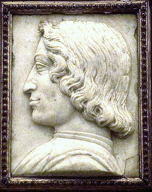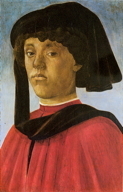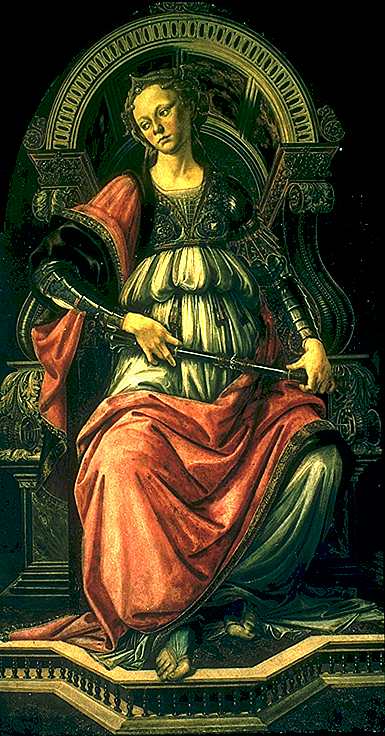

This is the painting which gave Botticelli his opportunity and endowed him with a nearly supernatural aura, which he is perhaps the first of the Renaissance to have had: that of the "cherished son of the gods" and of "divine prodigy". This type of halo, of mandorla which surrounded Botticelli brought him the fame which has not faltered to this day. This is a very young artist's first painting, which all of Florence went to see, enabling him to advantage of rather extraordinary publicity opportunities. This allegorical painting is 1.75 m (69") high and was painted to serve as a chair back. One of the great Commercial Courts of the busy city of Renaissance Florence, the Court of the Mercanzia, redecorated its premises, ordered new stalls and came up with the idea, very Renaissance, moreover, to decorate the tall chair backs with painted compositions representing the great virtues. A very young Botticelli received the commission for the foremost virtue: Fortitude. When the Court was dissolved in 1771, the work was window transferred to the Academia, where it languished in the attic; from there, it went to the Uffizi, where it remained in custody, and it was not until 1863 that it was rediscovered and exhibited where it is today: amongst the masterpieces of the first Renaissance. Curiously enough, it is not yet with the Uffizi Gallery's collection of Botticelli's works, three rooms before, but with the set of seven chair backs, where we shall replace it later.
It is 1470, and we are in Florence. Barely fifty years have passed since last week's lecture, yet the world has nearly completely turned; we shall, as usual, pick up the chapters of Western and Eastern history to appraise what was going on while Sandro Botticelli was painting Fortitude. World Events in 1470: in France , en England, in Spain, the Ottoman Empire, China, and Japan.
World Events in 1470 - France
This was all fine, the army, the taxes, the people and the territory, but there were also some problems. The nobility was totally opposed to the king's strange democratism, and it rose up against him. This rebellion, led by the nobility, has retained a name in history: the Praguerie. Charles VII put it down without pity, even after learning that his own son, the Dauphin, was a leader of this rebellion, second only to the most vociferous of the insurgents. This Dauphin was the future Louis XI, whom we shall see again soon. Then, there was the Church: the Pope had taken advantage of the English presence and, catastrophically, had managed to interfere with the affairs of its beloved daughter, France, and was assuming a more and more invasive stance.
On July 7, 1438, in the Cathedral of Bourges, Charles VII reacted with extraordinary violence and signed the Pragmatic Sanction, an edict in his name: "I, the king of France, forbid Peter's successor, that is, the Pope, to interfere with the nomination of Bishops and, more generally, in French church affairs." This was the first time that such a text had been promulgated, and it nearly brought about Charles VII's excommunication, but he was on such a trail of glory, and his aura was so predominant in Europe, that the Pope decided to back down. The Pragmatic Sanction has remained in effect since 1438. These are significant achievements for one man, who still found the time to father many children, eleven, to be exact, with his wife and four with his mistress. This mistress must be noted, as she was the first royal mistress in the history of France, the famous Agnès Sorel, known as the "Dame de Beauté", not because she was beautiful but because of the castle given to her by the king, The Castle of Beauté-sur-Marne. She was one of the women who championed Italian refinement in the French Court.
Charles VII died and was succeeded by Louis XI. Talking about Charles VII at such length takes on a certain importance, as Louis XI would take advantage of the climate of total improvement which his father had not only undertaken but achieved: Louis XI inherited a healthy France, which was very significant. Louis XI also had to put down rebellions, including those of his erstwhile Praguerie accomplices. When one becomes slightly revolutionary, a conspirator, one is unable not to continue, even when one's cousin's castle and assets have been confiscated and he sent into exile, which happened to many of the nobles under Charles VII. One convinced oneself that one might perhaps succeed.
The nobles continued hatching their devious plots under Louis XI's reign, and the names are the same as those of his accomplices in the Praguerie, replaced by their nephews. But Louis XI knew how these hidden rebellions were organized, he knew how to put them down and he struck viciously. Feeling well at home, in France, he turned to France's enemy, Burgundy, alternately an historic ally or enemy. Philip the Good had died, and his son had taken his place. He was 37 years old, ten years younger than Louis XI. Louis XI was ugly, while Charles the Bold, the Duke of Burgundy was as handsome as a Greek god. Louis XI detested the Duke of Burgundy, Burgundy and her influence and wealth, and he fought as best he could to limit Burgundian authority. Then, he had an absolutely stunning idea: he urged Burgundy's proprietary cities, Liege and Ghent, to revolt, and it worked. Somewhat panicked, Charles the Bold summoned him to talk about France's and Burgundy's future. Louis XI rushed to Péronne, sure that he would find a dejected Charles the Bold; instead, this turned into the Péronne incarceration, during which King Louis XI remained the Duke of Burgundy's prisoner until he signed all that Charles needed to remain the leading player in the West.
At the time that Botticelli was painting Fortitude, Louis XI had nearly become a great king but had lost a great deal of his advantages because of the foolishness of the Péronne meeting. In 1470, he had just gotten out of Péronne, and, still upset, he was skirting the issues, unable to accept what had been done to him; he retaliated by imprisoning all those people who, in one way or another, had dealt with Charles the Bold during his involuntary incarceration, including the Cardinal of Balue, who was the first to inhabit the prisons invented by Louis XI, sophisticated prisons known as "fillettes".That's about it for France; it can be said that it was perhaps healthier than it was 45 years earlier, but it should have been much more so. Louis XI still had to learn "the tricks of the trade"; he was too greedy and too quick off the mark, and Charles the Bold pulled a great coup on him with the Péronne meeting.
World Events in 1470 - France
World Events in 1470 - England
World Events in 1470 - England
World Events in 1470 - Spain
World Events in 1470 - Spain
World Events in 1470 - The Ottoman Empire
World Events in 1470 - The Ottoman Empire
World Events in 1470 - China
World Events in 1470 - China
World Events in 1470 - Japan
World Events in 1470 - Japan
The Florence and Medicis page remains, which we shall open now, before devoting ourselves to his biography, to two commissioned works the Lemmi Villa frescos and those in the Sistine Chapel. We shall then come back to the Allegory of Fortitude and then approach his work : the religious works, including the Mystical Nativity, and the secular works, in particular the Birth of Venus and Spring, without neglecting the Story of Nastagio degli Onesti. Finally, we shall admire the drawings which will bring us to the conclusion of today's lecture on Sandro Botticelli.
Florence and Medicis
It was a republic at the time of Masaccio and was no longer quite that in Botticelli's time; the Medicis had succeeded in taking over Florence's government, if not the power. We are in the reign of the greatest of the three, Lorenzo the Magnificent.
The dynasty was founded by Cosimo the Elder and his wife, Contesina de Bardi. One of their children, a son, was called Piero; because of a precocious form of arthritis, he was known as Piero the Gouty. Having become master of Florence, Piero had married the admirable Lucrezia Tornabuoni, one of the most beautiful figures that the history of sculpture and painting has left us. They had children, amongst whom, the present ruler, Lorenzo, known as Lorenzo the Magnificent. Lorenzo had two successive wives: the first, Philippina, an illegitimate child of Savoy - this was fine as long as Lorenzo was simply Lorenzo, but was no longer suitable when he became the Magnificent. Her lord thanked Philippina and then married Clarissa Orsini, thus creating a magnificent Orsini-Medici dynastic liaison, once again two powers which complemented each other very well. They would have three important children together; the first was Piero II, known as Piero the Exile who brought an end to the great Medicis by stupidly getting thrown out of Florence. The second was Giuliano, better known as the Duke of Nemours, who left an important imprint on both Italian and French literature. The third was called Giovanni, the most glorious of the three, as he became one of the Renaissance's great popes under the name Leo X.
Nous sommes à l'époque des fameux trois premiers Médicis qui tissent, avec une sûreté de jugement absolument formidable, la toile de leurs alliances et de leurs intérêts pour asseoir de mieux en mieux Florence qui est vraiment en train de devenir ce que Laurent voulait : la nouvelle Alexandrie, c'est-à-dire véritablement le phare du monde.
We are now in the era of the famous first three Medicis, who were weaving, with an absolutely formidable confident judgment, the fabric of their alliances and interests in order to increasingly consolidate Florence, which was truly becoming what Lorenzo wanted it to be: the new Alexandria, or the Lighthouse of the world. In fact, when Piero gave up his power, he left it not only to Lorenzo, but to his two sons, Lorenzo and Giuliano, both of them holding the title of "principi estate", Prince of State. Only later would Lorenzo rule alone, after April 1478, the date of the terrifying plot to assassinate the Medicis in the Duomo. Lorenzo was able to flee thanks to an open sacristy door, but Giuliano lost his life there. From that date on, Lorenzo the Magnificent was Florence's sole master and presided over its destiny until his death on April 8, 1492. The Medici portraits A small gallery of these characters, whose faces are sometimes unexpected:
The Medici portraits A small gallery of these characters, whose faces are sometimes unexpected:





In this era of great celebration, the artists, the sculptors as well as the painters, served the dynasty and its allies. We shall now see several portraits of great Florentines of this period.Naturally, Botticelli was a painter for the Medicis, and they often called on him for portraits which were sent all over the Western world




The dynasty was founded by Cosimo the Elder and his wife, Contesina de Bardi. One of their children, a son, was called Piero; because of a precocious form of arthritis, he was known as Piero the Gouty. Having become master of Florence, Piero had married the admirable Lucrezia Tornabuoni, one of the most beautiful figures that the history of sculpture and painting has left us. They had children, amongst whom, the present ruler, Lorenzo, known as Lorenzo the Magnificent. Lorenzo had two successive wives: the first, Philippina, an illegitimate child of Savoy - this was fine as long as Lorenzo was simply Lorenzo, but was no longer suitable when he became the Magnificent. Her lord thanked Philippina and then married Clarissa Orsini, thus creating a magnificent Orsini-Medici dynastic liaison, once again two powers which complemented each other very well. They would have three important children together; the first was Piero II, known as Piero the Exile who brought an end to the great Medicis by stupidly getting thrown out of Florence. The second was Giuliano, better known as the Duke of Nemours, who left an important imprint on both Italian and French literature. The third was called Giovanni, the most glorious of the three, as he became one of the Renaissance's great popes under the name Leo X.
Nous sommes à l'époque des fameux trois premiers Médicis qui tissent, avec une sûreté de jugement absolument formidable, la toile de leurs alliances et de leurs intérêts pour asseoir de mieux en mieux Florence qui est vraiment en train de devenir ce que Laurent voulait : la nouvelle Alexandrie, c'est-à-dire véritablement le phare du monde.
We are now in the era of the famous first three Medicis, who were weaving, with an absolutely formidable confident judgment, the fabric of their alliances and interests in order to increasingly consolidate Florence, which was truly becoming what Lorenzo wanted it to be: the new Alexandria, or the Lighthouse of the world. In fact, when Piero gave up his power, he left it not only to Lorenzo, but to his two sons, Lorenzo and Giuliano, both of them holding the title of "principi estate", Prince of State. Only later would Lorenzo rule alone, after April 1478, the date of the terrifying plot to assassinate the Medicis in the Duomo. Lorenzo was able to flee thanks to an open sacristy door, but Giuliano lost his life there. From that date on, Lorenzo the Magnificent was Florence's sole master and presided over its destiny until his death on April 8, 1492.
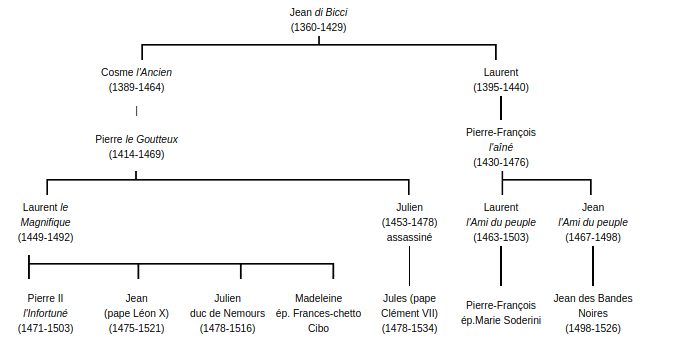 The Medici portraits A small gallery of these characters, whose faces are sometimes unexpected:
The Medici portraits A small gallery of these characters, whose faces are sometimes unexpected: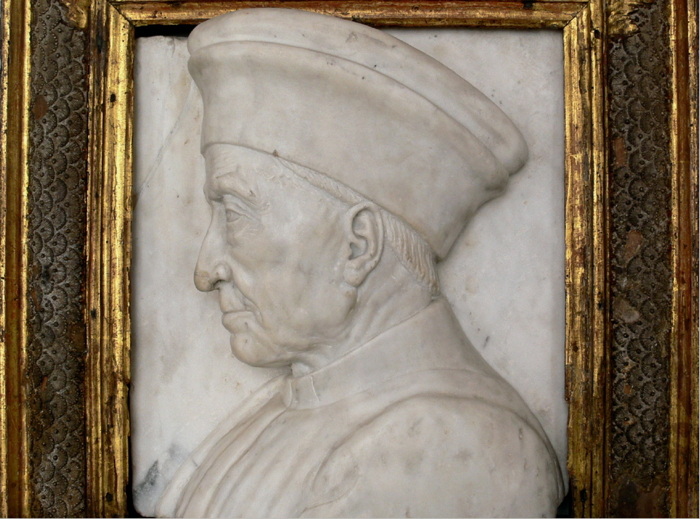
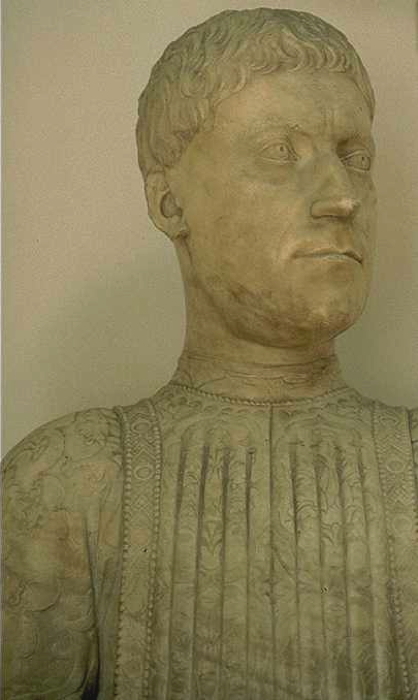
Cosme l'Ancien
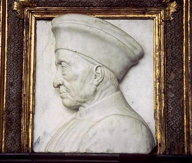
Piero the Gouty
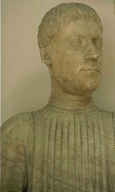
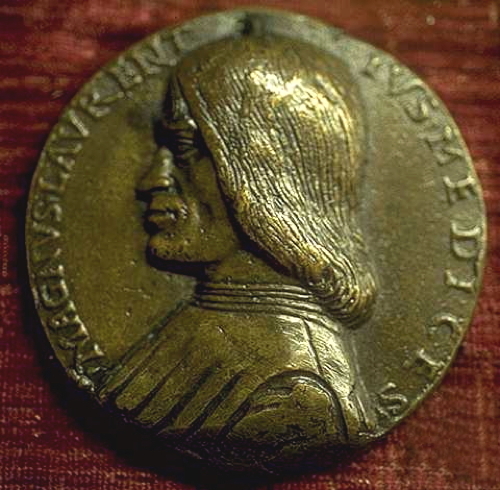
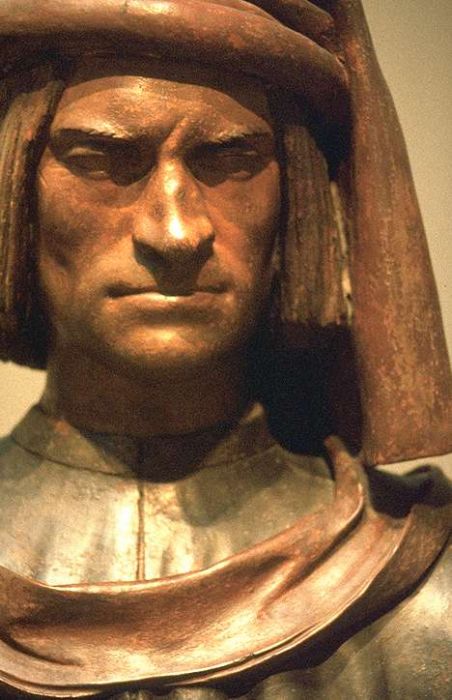
Lorenzo the Magnificent
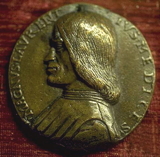
Lorenzo the Magnificent
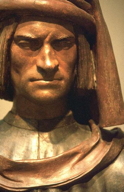
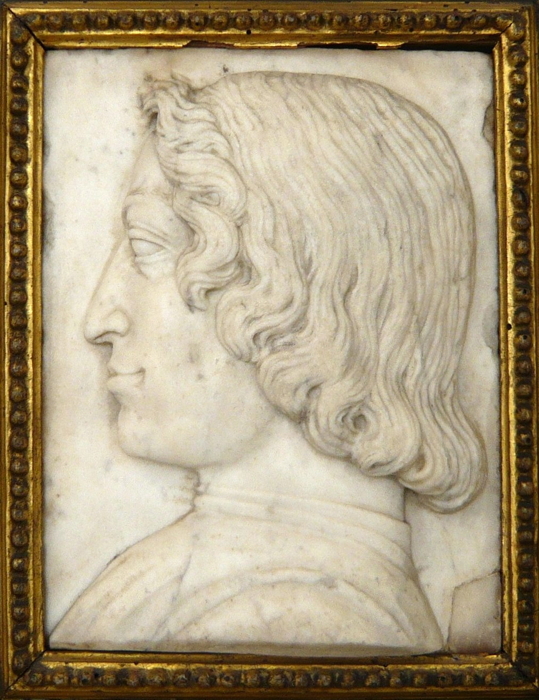
In this era of great celebration, the artists, the sculptors as well as the painters, served the dynasty and its allies. We shall now see several portraits of great Florentines of this period.Naturally, Botticelli was a painter for the Medicis, and they often called on him for portraits which were sent all over the Western world
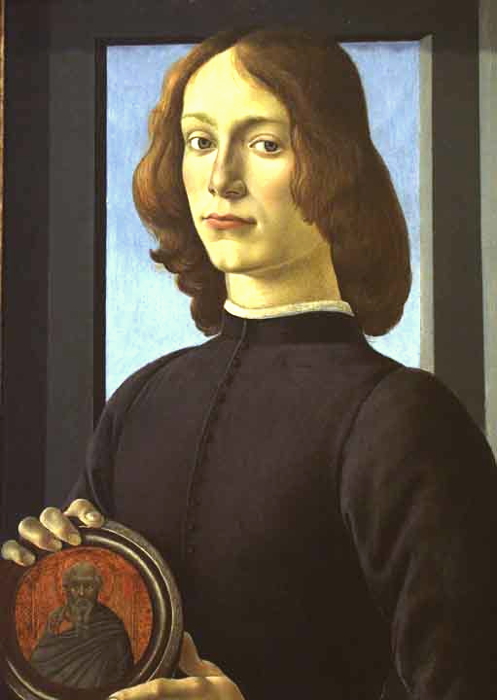
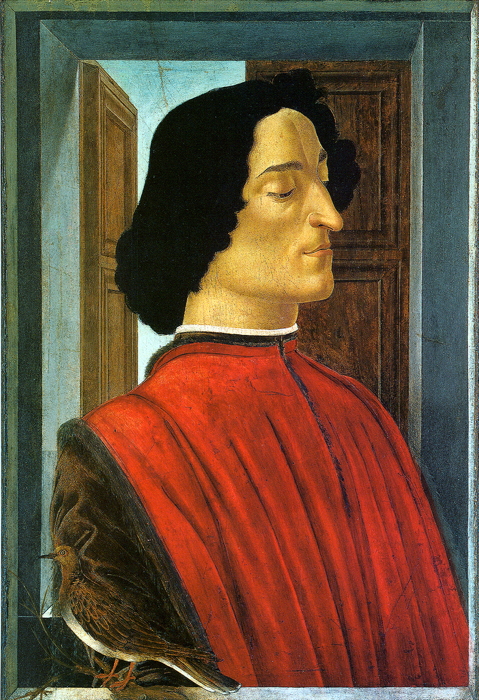
Portrait d'un jeune homme un Médicis ?
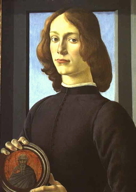
This could very well be Botticelli's first commissioned work, and from the hair and the clothes, the portrait must date from no later than 1468.

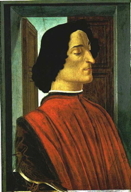
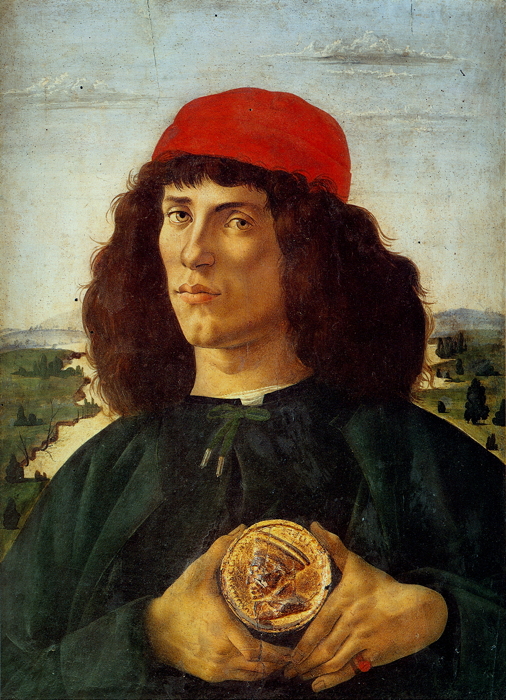
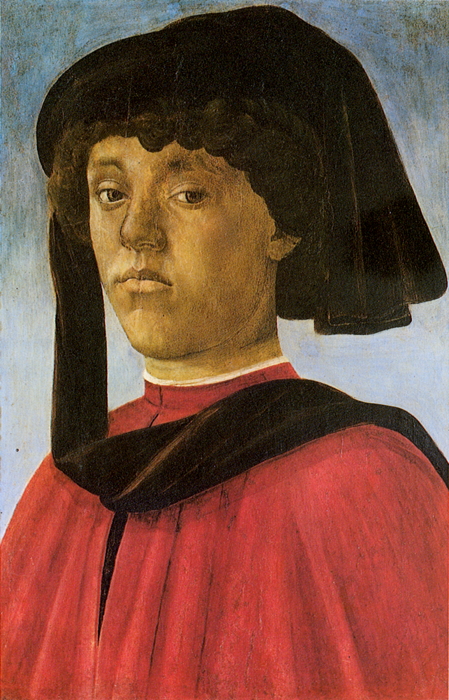
Anonymous portrait (Portrait of a man with a medal)
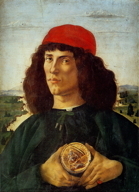
Florence and Medicis
This will be very limited, as we will only use what is needed to understand what follows. He was born in 1445 in the Ognissanti parish in Florence, where he was registered as Alessandro, the son of di Mariano dei Filipepi. One rather curious thing - his father was fifty years old, and his mother was forty - this was very old. This would pursue him through life, as Sandro Botticelli's health was always very fragile, and the doctors would opine that he was born too late to parents who were too old. We know that his father took advantage of his birth to reregister his other children in the parish register, and we thus know that Sandro was his fourth child and, as it happens, his fourth son. All of them would be very successful: the eldest, Giovanni, would be a Florentine bank broker; the second, Antonio, would be a goldsmith; the third, Simone, would spend the greater part of his career in Naples with the Florentine Rucellai family in the cloth business with Spain. Sandro was thus the runt. The Botticelli family was far from being mediocre or poor. The 19th century art historians would have liked us to believe that Botticelli came from nowhere to become a god of painting - this is untrue. He came from the upper middle class. He was thus registered as Alessandro, which was shortened to Sandro; during his entire life, people would say "Sandro bello a mal sacro - Sandro is handsome but unhealthy", because he was always pale.
As to his name, why Botticelli? Here, there are also several hypotheses; his name was dei Filipepi, why don't we know him under that name? There appear to be two possible explanations: one of them is true, and you can each make your own choice (depending on how you feel about it). His elder brother, Giovanni, the family patriarch, was enormous, fabulously obese, and he had been nicknamed "Botticella", which means "keg" in Tuscan. Those close to the "Botticella" became "Botticelli", and that was where Botticelli's name supposedly came from - it's possible. The second explanation is more likely to be true: the family's second son was a goldsmith, and, as such, one of his privileges was the right to beat gold. We know that as soon as Botticelli reached the age of fourteen, his brother used him to help beat the gold. A gold beater was called a "battigello", which gradually became Botticelli - it's also possible.
Sandro dei Filipepi, also known as Botticelli, decided to become a painter. He served an apprenticeship with Fra Filippo Lippi, the best Florentine painter of that time and perfected his art with Andrea Verrocchio, who created the bust of Lucrezia Donati which we saw earlier. Finally, in 1470, he decided that he was accomplished enough as a painter to go out on his own, and it was at that moment, in an extraordinary stroke of luck, that he was commissioned to paint the famous Allegory of Fortitude which we have already seen, and which we shall look at again. This Allegory of Fortitude would launch him. All of Florence came to see it, and the painter was much admired. The great Florentine families who were always in search of young artists who could contribute something to increase their prestige, flocked to him to have a Madonna painted, a Saint Elizabeth, a Saint Augustine. It was nearly a period of line production work, during which Botticelli painted small dimension paintings through which he entered Florentine society.
He received his stamp of approval at 10 am on January 28, 1475; the bells of Santa Croce were all pealing wildly, because, as it happened every five years, the Medicis were offering Florence a joust - this was still done during the High Renaissance. Giuliano de' Medici was this joust's hero, with his armor, shield, sword, plumes - it was grandiose and Florence remembered it with emotion. But, and this was the most important, the hero's emblem floated at the end of a pole: his banner was fabulous and had been painted by Sandro Botticelli.
This work, borne by Florence's master, transformed Botticelli not only into the protégé of the gods, but also the protégé of princes. Botticelli's great career began soon after. To summarize this great career, we are going to look at two commissions - one profane: two frescoes in the Lemmi Villa, , and the other sacred: those in the Sistine Chapel, which are little-known Botticelli works.


The Temptation of Christ
In a series of sequential scenes, we can see the moments of the temptation of Christ, amongst which, the culminating moment: Atop the Temple, Satan shows Christ the world and tells him that "All this is yours". Along the way, other moments of this temptation of Christ are presented in groups which end when Satan, finally defeated, opts to throw himself from the top of the rocks rather than to continue to witness Christ's ardor. Botticelli recounts the Temptations of Christ in a somewhat medieval manner, juxtaposing several stories in a single scene, at the risk of making it denser, which it does. One detail in the Adoration of the Eucharist, the big central scene is admirable - the bearer of offerings, who recalls one of the Graces at the Lemmi Villa and who is a forebear of the Graces of Spring.


The Trials of Moses
 This fresco is just as ponderous and complex. The burning bush, representing Moses' encounter with God, is there, along with Jethro's daughters, the preparations for the ascent of Mount Sinai with Moses baring his feet, Moses striking an Egyptian, as he does not yet know that he is not Egyptian.
This fresco is just as ponderous and complex. The burning bush, representing Moses' encounter with God, is there, along with Jethro's daughters, the preparations for the ascent of Mount Sinai with Moses baring his feet, Moses striking an Egyptian, as he does not yet know that he is not Egyptian.
All these episodes of Moses' history converge on Jethro's well, the central confluence, with the two figures of Jethro's daughters, all in white; once again, we find this lily-white translucency, in which Botticelli's continuing orientation toward an infinitely elegant and delicate art can be seen.

The Punishment of Korah, Dathan and Abiram
A superb story, very vividly told, this is one of the first times that Botticelli set out to tell a perfectly dynamic story which even mimics persons. The whole painting is brought together by a superb landscape, the most successful of all; this landscape is further unified by anearly exact copy of the Arch of Constantine which Botticelli introduced into this scene, a nearly completely archeological visionof this Roman monument against a background of a lake and mountains, which gives the whole painting exceptional vigor and power.

As to his name, why Botticelli? Here, there are also several hypotheses; his name was dei Filipepi, why don't we know him under that name? There appear to be two possible explanations: one of them is true, and you can each make your own choice (depending on how you feel about it). His elder brother, Giovanni, the family patriarch, was enormous, fabulously obese, and he had been nicknamed "Botticella", which means "keg" in Tuscan. Those close to the "Botticella" became "Botticelli", and that was where Botticelli's name supposedly came from - it's possible. The second explanation is more likely to be true: the family's second son was a goldsmith, and, as such, one of his privileges was the right to beat gold. We know that as soon as Botticelli reached the age of fourteen, his brother used him to help beat the gold. A gold beater was called a "battigello", which gradually became Botticelli - it's also possible.
Sandro dei Filipepi, also known as Botticelli, decided to become a painter. He served an apprenticeship with Fra Filippo Lippi, the best Florentine painter of that time and perfected his art with Andrea Verrocchio, who created the bust of Lucrezia Donati which we saw earlier. Finally, in 1470, he decided that he was accomplished enough as a painter to go out on his own, and it was at that moment, in an extraordinary stroke of luck, that he was commissioned to paint the famous Allegory of Fortitude which we have already seen, and which we shall look at again. This Allegory of Fortitude would launch him. All of Florence came to see it, and the painter was much admired. The great Florentine families who were always in search of young artists who could contribute something to increase their prestige, flocked to him to have a Madonna painted, a Saint Elizabeth, a Saint Augustine. It was nearly a period of line production work, during which Botticelli painted small dimension paintings through which he entered Florentine society.
He received his stamp of approval at 10 am on January 28, 1475; the bells of Santa Croce were all pealing wildly, because, as it happened every five years, the Medicis were offering Florence a joust - this was still done during the High Renaissance. Giuliano de' Medici was this joust's hero, with his armor, shield, sword, plumes - it was grandiose and Florence remembered it with emotion. But, and this was the most important, the hero's emblem floated at the end of a pole: his banner was fabulous and had been painted by Sandro Botticelli.
This work, borne by Florence's master, transformed Botticelli not only into the protégé of the gods, but also the protégé of princes. Botticelli's great career began soon after. To summarize this great career, we are going to look at two commissions - one profane: two frescoes in the Lemmi Villa, , and the other sacred: those in the Sistine Chapel, which are little-known Botticelli works.
Lemmi Villa
Two frescoes in the Lemmi Villa
Several years after the joust, a very flattering commission from the Tornabuoni family brought Botticelli to their villa beyond the city walls, the Tornabuoni Villa, currently known as the Lemmi Villa. They wanted him to paint two frescoes on the loggia walls, as their son, Lorenzo Tornabuoni, was about to marry Giovanna Albizzi, another example of those Florentine marriages which was to everyone's advantage. As the big ceremony was take place in the villa's loggia, it had to be decorated, and Botticelli was asked to do this.


Giovanna paying homage to Venus and the Graces
Most notably in the Graces, one can already see all the feeling of roundness, the sinuosity of the line which truly make a Botticelli painting a divine painting.

Lorenzo received by the Liberal Arts procession
Sandro Botticelli was one of the first during the Renaissance who dared to show people in full-face, three-quarter-face and even from behind and gives us the impression of this strange learned assembly toward which this austere young man was seemingly being pushed. An admirable fresco, if only because of the splendid severity of the young man's profile and because of the details of the Liberal Arts, in which one finds the same feeling of evanescence, of line movement, which allow even images as severe as those of the Arts Libéraux to take on an absolutely extraordinary divine aura.

These frescoes are not in very good shape, as soon after the wedding, they were whitewashed - this type of decoration was not meant to last. How many works of the Masters - da Vinci, Mantegna and others - have we lost, because they were decorations for parties? With no malice aforethought, they were simply whitewashed to change the decor. It was only in 1863 while doing some construction work, that the Lemmi family, which had inherited this villa from the Tornabuoni family, discovered that there was something under the whitewash. Birnari, the antique dealer was called in, and he immediately saw that there was something worthwhile and offered to buy them: he had recognized Botticelli's work. He had to work quickly and make sure that the heirs did not find out before the construction was finished; he had the frescoes stripped and separated so badly that he lost more half of them. It would take him more than eleven years to sell these Botticelli phantoms. The Musée du Louvre finally bought them.
Several years after the joust, a very flattering commission from the Tornabuoni family brought Botticelli to their villa beyond the city walls, the Tornabuoni Villa, currently known as the Lemmi Villa. They wanted him to paint two frescoes on the loggia walls, as their son, Lorenzo Tornabuoni, was about to marry Giovanna Albizzi, another example of those Florentine marriages which was to everyone's advantage. As the big ceremony was take place in the villa's loggia, it had to be decorated, and Botticelli was asked to do this.
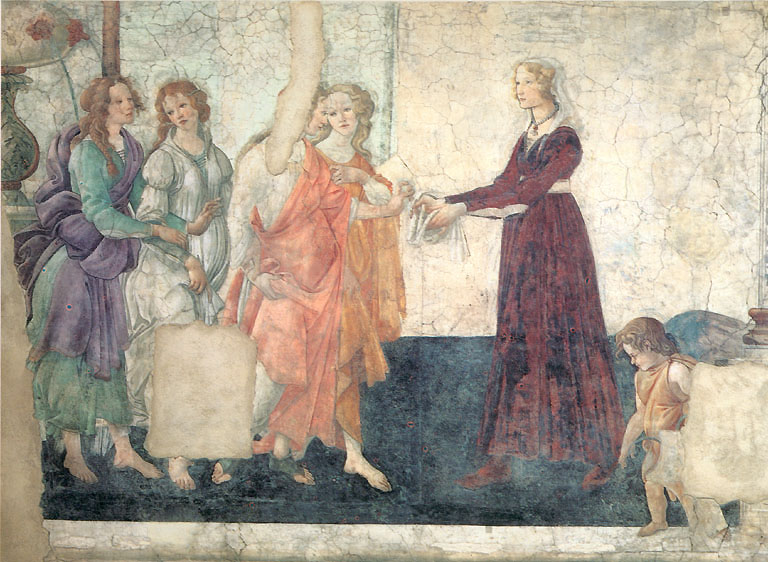
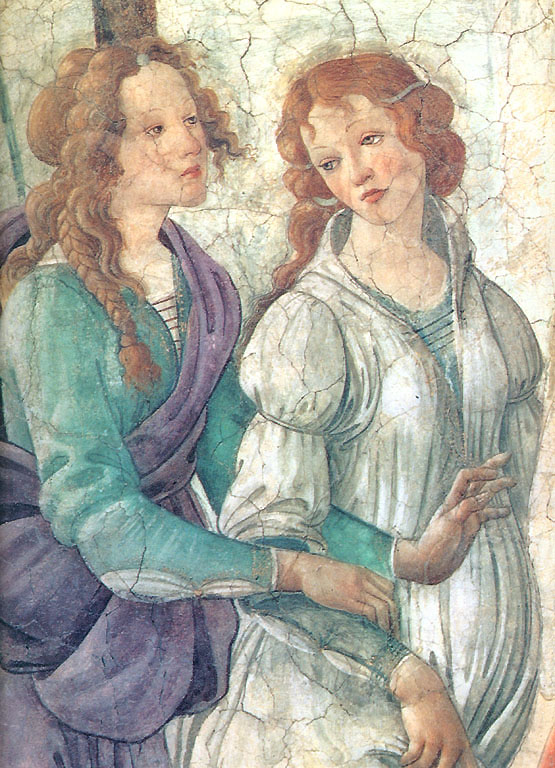
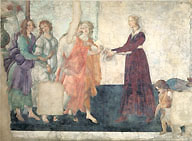
Giovanna paying homage to Venus and the Graces
Most notably in the Graces, one can already see all the feeling of roundness, the sinuosity of the line which truly make a Botticelli painting a divine painting.
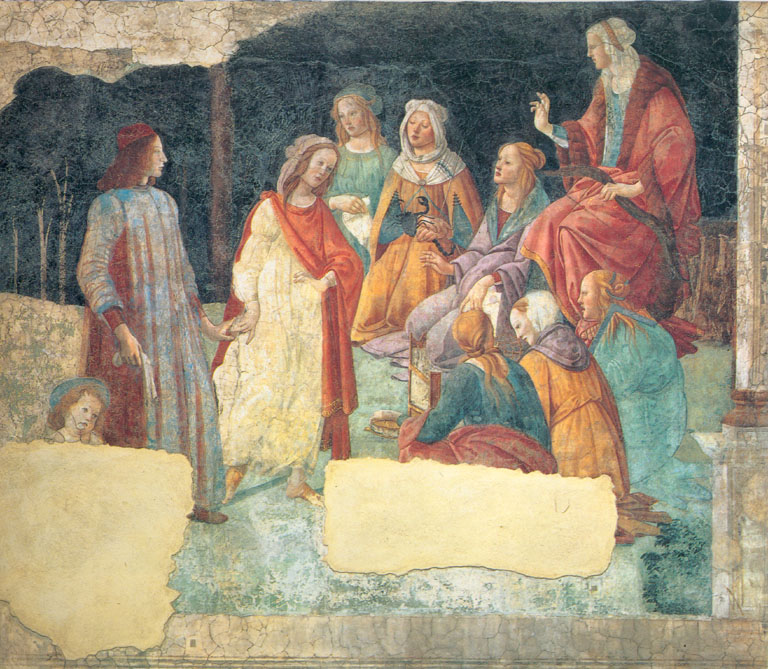
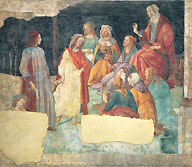
Lorenzo received by the Liberal Arts procession
Sandro Botticelli was one of the first during the Renaissance who dared to show people in full-face, three-quarter-face and even from behind and gives us the impression of this strange learned assembly toward which this austere young man was seemingly being pushed. An admirable fresco, if only because of the splendid severity of the young man's profile and because of the details of the Liberal Arts, in which one finds the same feeling of evanescence, of line movement, which allow even images as severe as those of the Arts Libéraux to take on an absolutely extraordinary divine aura.
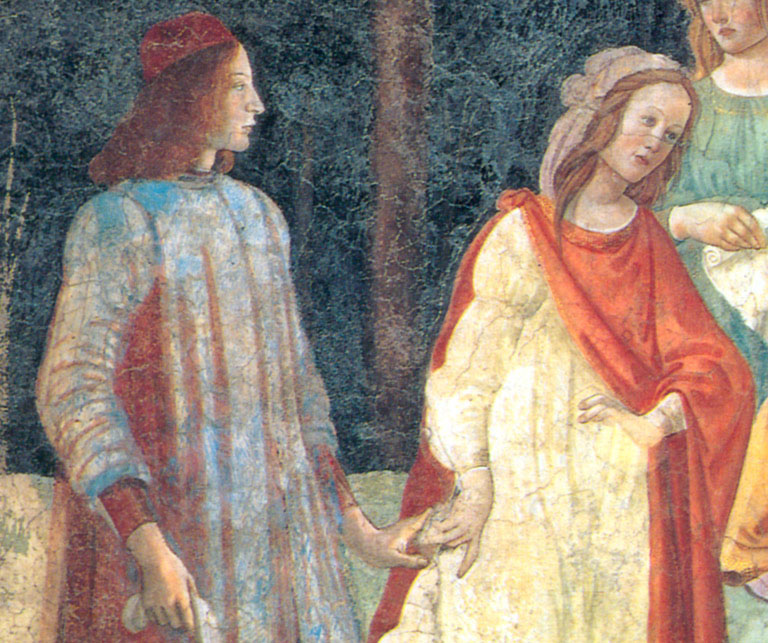
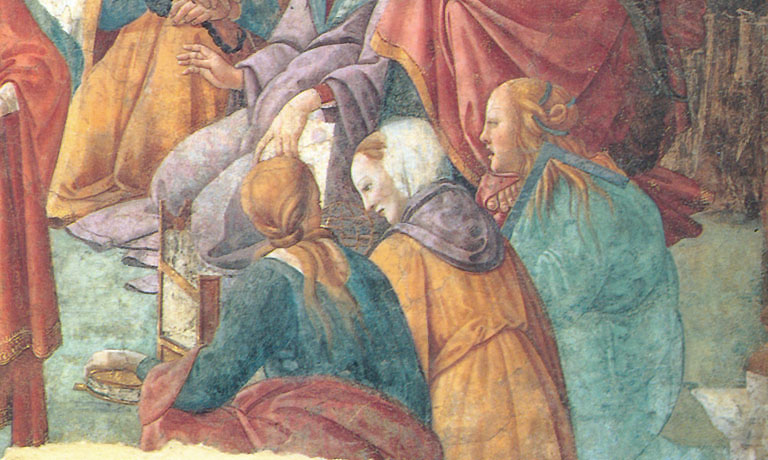
These frescoes are not in very good shape, as soon after the wedding, they were whitewashed - this type of decoration was not meant to last. How many works of the Masters - da Vinci, Mantegna and others - have we lost, because they were decorations for parties? With no malice aforethought, they were simply whitewashed to change the decor. It was only in 1863 while doing some construction work, that the Lemmi family, which had inherited this villa from the Tornabuoni family, discovered that there was something under the whitewash. Birnari, the antique dealer was called in, and he immediately saw that there was something worthwhile and offered to buy them: he had recognized Botticelli's work. He had to work quickly and make sure that the heirs did not find out before the construction was finished; he had the frescoes stripped and separated so badly that he lost more half of them. It would take him more than eleven years to sell these Botticelli phantoms. The Musée du Louvre finally bought them.
Lemmi Villa
The Sistine Chapel Frescoes
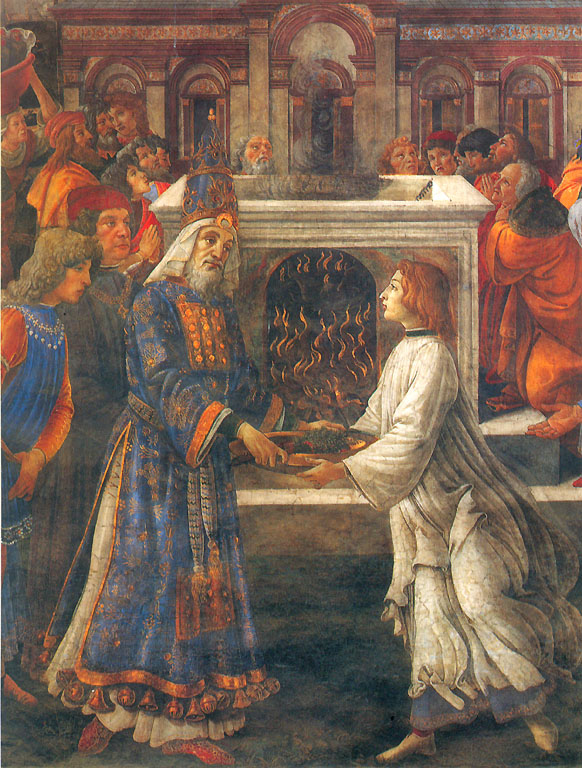

The Temptation of Christ
In a series of sequential scenes, we can see the moments of the temptation of Christ, amongst which, the culminating moment: Atop the Temple, Satan shows Christ the world and tells him that "All this is yours". Along the way, other moments of this temptation of Christ are presented in groups which end when Satan, finally defeated, opts to throw himself from the top of the rocks rather than to continue to witness Christ's ardor. Botticelli recounts the Temptations of Christ in a somewhat medieval manner, juxtaposing several stories in a single scene, at the risk of making it denser, which it does. One detail in the Adoration of the Eucharist, the big central scene is admirable - the bearer of offerings, who recalls one of the Graces at the Lemmi Villa and who is a forebear of the Graces of Spring.
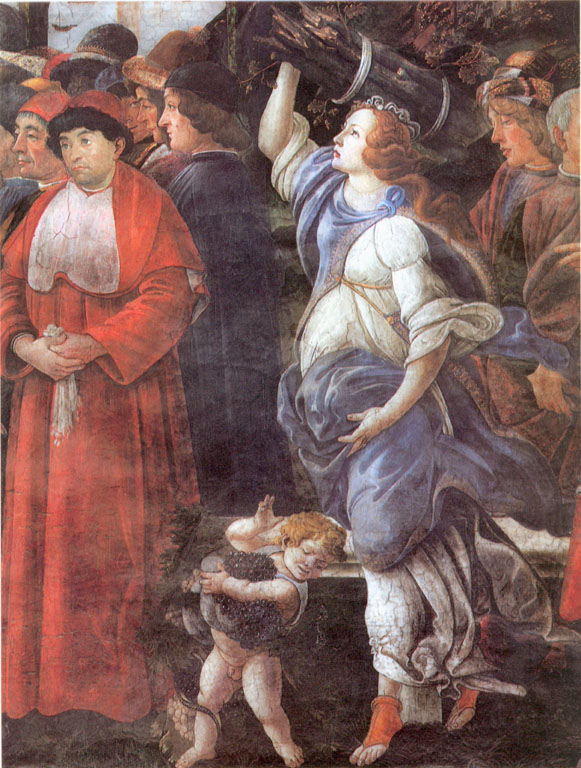
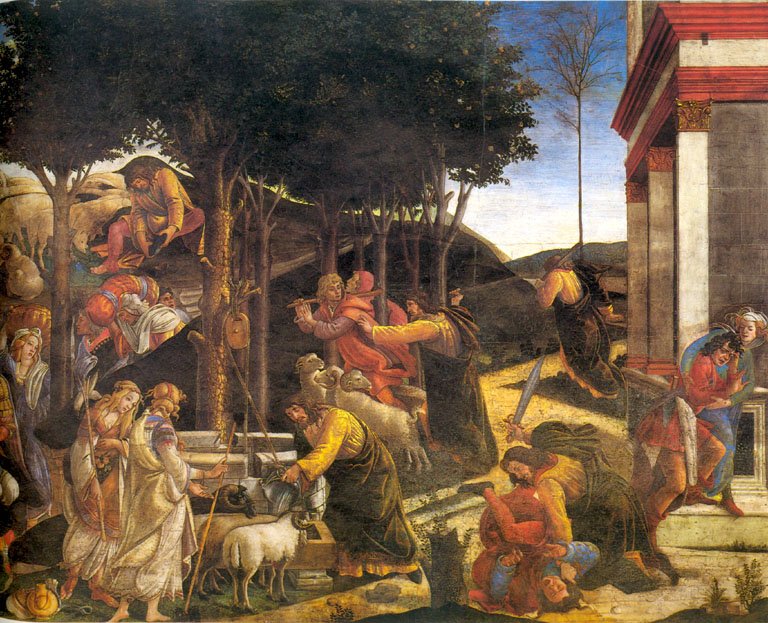

The Trials of Moses
 This fresco is just as ponderous and complex. The burning bush, representing Moses' encounter with God, is there, along with Jethro's daughters, the preparations for the ascent of Mount Sinai with Moses baring his feet, Moses striking an Egyptian, as he does not yet know that he is not Egyptian.
This fresco is just as ponderous and complex. The burning bush, representing Moses' encounter with God, is there, along with Jethro's daughters, the preparations for the ascent of Mount Sinai with Moses baring his feet, Moses striking an Egyptian, as he does not yet know that he is not Egyptian. All these episodes of Moses' history converge on Jethro's well, the central confluence, with the two figures of Jethro's daughters, all in white; once again, we find this lily-white translucency, in which Botticelli's continuing orientation toward an infinitely elegant and delicate art can be seen.
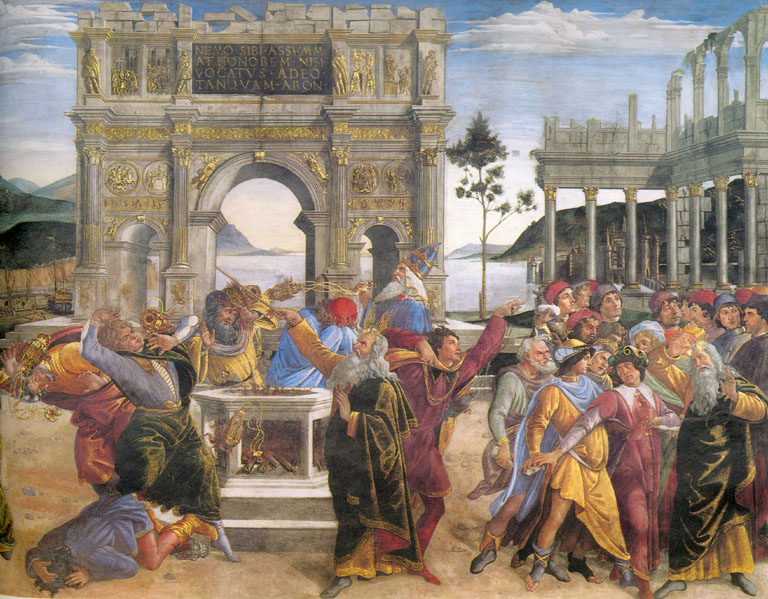

The Punishment of Korah, Dathan and Abiram
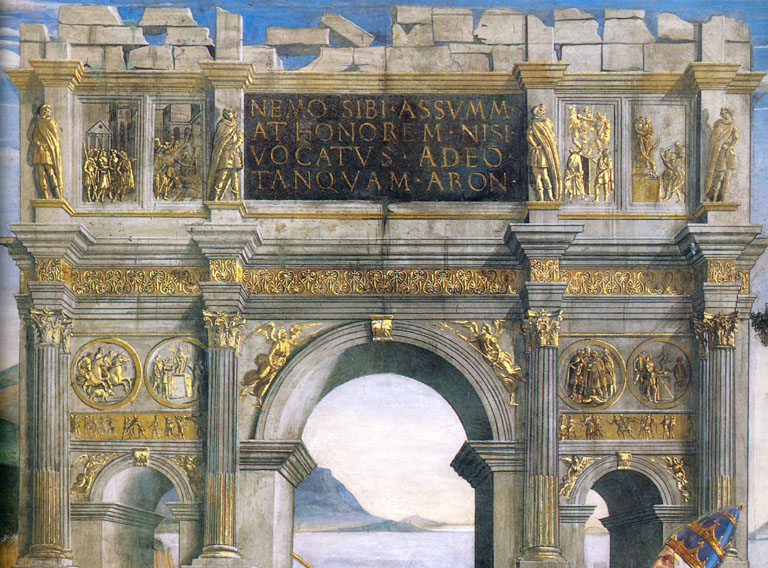
The Sistine Chapel Frescoes
In December 1469, the Court of the Mercanzia in Florence, located on the Piazza della Signoria, opposite the Palace, became aware that the Court had to be completely restored, taking advantage of the "Christmas vacancy" as they used to say at the time. The courtroom itself had to be completely redone, as did the furniture. It was at that time that the seven Magistrates - there were six magistrates and a revolving presiding magistrate - decided that they wanted large chairs with high backs covered with images of the Virtues. They then had to choose the artist, and they chose Pollaiuolo, not Antonio, the great one, but his brother Piero, who spent Christmas and New Year's sketching the Virtues, which were preserved and which we shall see later. These are very good paintings, but still done in a very traditional style, very much the style of the first half of the Quatrocento.


Faith


Prudence
The robe's broken-up pleats give it a monumental character.


La Justice
 With her large, gleaming sword and the celestial orb, over which, like any justice, she must reign forever.
This is good painting, a little two-dimensional and a bit dull, with some Gothic influence visible in the sharp quality of the robes. As it happened, one of the Mercanzia seven was a person called Rudelai; every time Pollaiuolo delivered a Virtue, his face became longer and longer, as he considered them ugly. He took it upon himself to order the seventh and last Virtue from an artist in whom he trusted called Sandro Botticelli, whom nobody had heard of. The six other Virtues had to be seen first to better understand how first the seven Judges, and then all of Florence, were so excited about this painting.
With her large, gleaming sword and the celestial orb, over which, like any justice, she must reign forever.
This is good painting, a little two-dimensional and a bit dull, with some Gothic influence visible in the sharp quality of the robes. As it happened, one of the Mercanzia seven was a person called Rudelai; every time Pollaiuolo delivered a Virtue, his face became longer and longer, as he considered them ugly. He took it upon himself to order the seventh and last Virtue from an artist in whom he trusted called Sandro Botticelli, whom nobody had heard of. The six other Virtues had to be seen first to better understand how first the seven Judges, and then all of Florence, were so excited about this painting.


Fortitude
 In Botticelli's work, it is true that we can see materials that really drape, models who really turn and whose stances are heroic, and, above all, it's painted with an exceptional joy of creation, right down to the las detail. It certainly sets itself completely apart from Piero de Pallaiuolo's paintings. And that was Sandro Botticelli's great stroke of luck.
In Botticelli's work, it is true that we can see materials that really drape, models who really turn and whose stances are heroic, and, above all, it's painted with an exceptional joy of creation, right down to the las detail. It certainly sets itself completely apart from Piero de Pallaiuolo's paintings. And that was Sandro Botticelli's great stroke of luck.
Rudelai was so happy with his choice that he talked about it all over Florence, and all of Florence came. But what made things even better - and this would have worked just as well in the 20th century - Pollaiuolo was so enraged that he launched an interpellation. At the outset, people tended to agree with him, if only because of the contract but disagreed with him once they had seen the works. As the luckless artists had told his story to the world, everybody talked about, everybody knew about it and all of Florence came to see the work Alessandro dei Filipepi, known as Botticelli - so young, so thin and so pale. That's how it all began. It is important to have spent some time on the circumstances, as it allows us to understand the special aura that cloaked Botticelli during his lifetime: he was not only a painter, a good painter or a great painter, he was the "cherished child of the gods".
This series of successes, in particular the seventh Virtue which dominated the other six, is something so exceptional, nearly miraculous, that Botticelli picked up this famous "cherished child of the gods" epithet, which was to be a great help to him throughout his career.
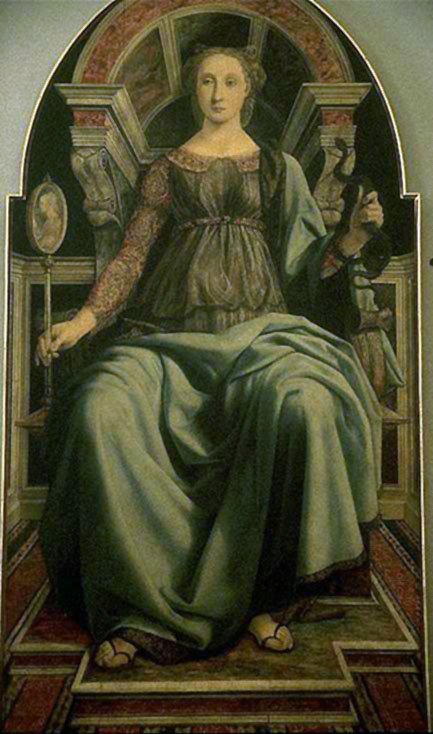

Faith
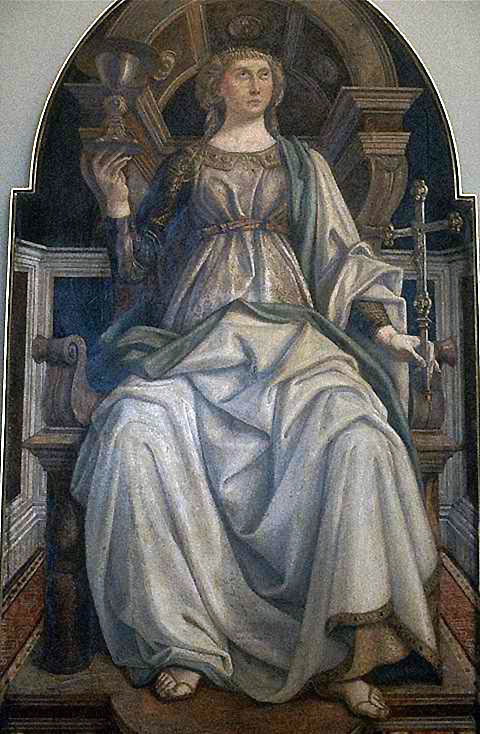

Prudence
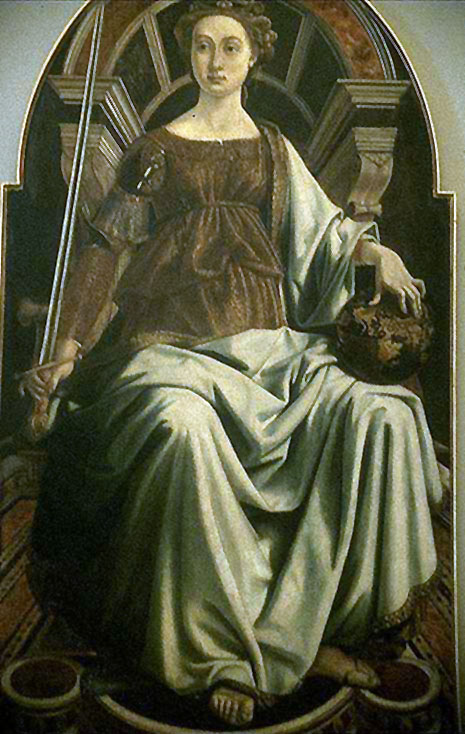

La Justice
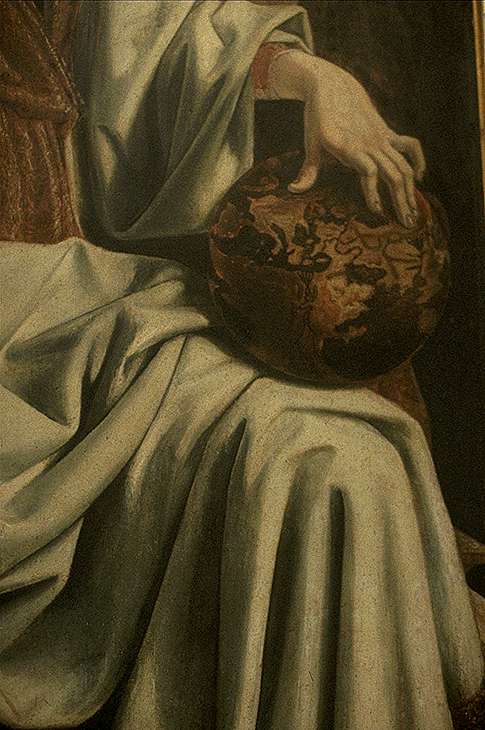 With her large, gleaming sword and the celestial orb, over which, like any justice, she must reign forever.
This is good painting, a little two-dimensional and a bit dull, with some Gothic influence visible in the sharp quality of the robes. As it happened, one of the Mercanzia seven was a person called Rudelai; every time Pollaiuolo delivered a Virtue, his face became longer and longer, as he considered them ugly. He took it upon himself to order the seventh and last Virtue from an artist in whom he trusted called Sandro Botticelli, whom nobody had heard of. The six other Virtues had to be seen first to better understand how first the seven Judges, and then all of Florence, were so excited about this painting.
With her large, gleaming sword and the celestial orb, over which, like any justice, she must reign forever.
This is good painting, a little two-dimensional and a bit dull, with some Gothic influence visible in the sharp quality of the robes. As it happened, one of the Mercanzia seven was a person called Rudelai; every time Pollaiuolo delivered a Virtue, his face became longer and longer, as he considered them ugly. He took it upon himself to order the seventh and last Virtue from an artist in whom he trusted called Sandro Botticelli, whom nobody had heard of. The six other Virtues had to be seen first to better understand how first the seven Judges, and then all of Florence, were so excited about this painting.
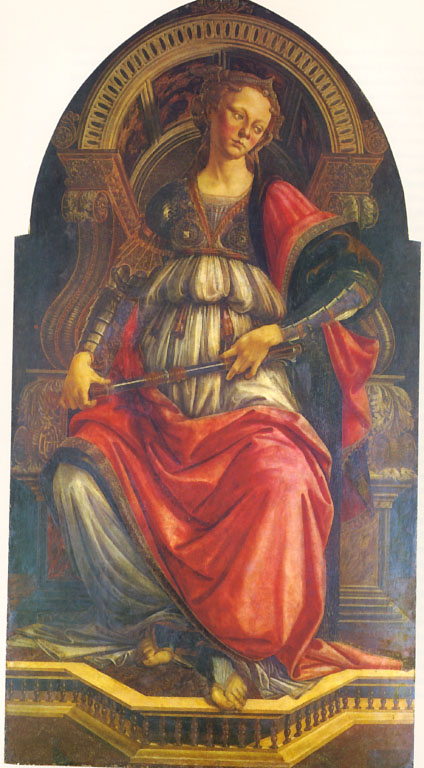

Fortitude
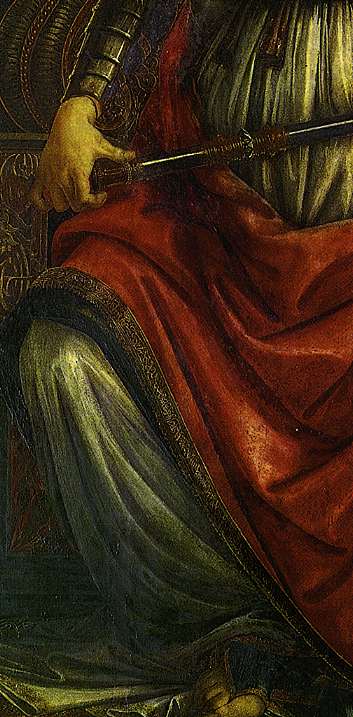 In Botticelli's work, it is true that we can see materials that really drape, models who really turn and whose stances are heroic, and, above all, it's painted with an exceptional joy of creation, right down to the las detail. It certainly sets itself completely apart from Piero de Pallaiuolo's paintings. And that was Sandro Botticelli's great stroke of luck.
In Botticelli's work, it is true that we can see materials that really drape, models who really turn and whose stances are heroic, and, above all, it's painted with an exceptional joy of creation, right down to the las detail. It certainly sets itself completely apart from Piero de Pallaiuolo's paintings. And that was Sandro Botticelli's great stroke of luck. Rudelai was so happy with his choice that he talked about it all over Florence, and all of Florence came. But what made things even better - and this would have worked just as well in the 20th century - Pollaiuolo was so enraged that he launched an interpellation. At the outset, people tended to agree with him, if only because of the contract but disagreed with him once they had seen the works. As the luckless artists had told his story to the world, everybody talked about, everybody knew about it and all of Florence came to see the work Alessandro dei Filipepi, known as Botticelli - so young, so thin and so pale. That's how it all began. It is important to have spent some time on the circumstances, as it allows us to understand the special aura that cloaked Botticelli during his lifetime: he was not only a painter, a good painter or a great painter, he was the "cherished child of the gods".
This series of successes, in particular the seventh Virtue which dominated the other six, is something so exceptional, nearly miraculous, that Botticelli picked up this famous "cherished child of the gods" epithet, which was to be a great help to him throughout his career.
As a painter, Botticelli is difficult to come to grips with, as his body of work is extremely varied. He goes from profane works to sacred works, from works which were unqualified successes to far more ponderous works. In both domains, Botticelli's work is very uneven. Were we to be shown his work in chronological order, our appreciation would fluctuate, and, at the end, we would not have a feeling of synthesis about his work. While preparing this lecture and assembling all the Madonnas, we came to the conclusion that there is not only one Sandro Botticelli, but two.
Looking at what came out of his atelier over time, that is to say in chronological order, we cannot grasp Botticelli's genius. When we realize that he approached Christian religious scenes and pagan religious scenes in a totally different manner, not only with a different brush and palette, but a different state of mind, we begin to see the light. This evening's lecture is what it is simply because we thought of regrouping the Madonnas. We will keep that order and look at a series of Botticelli's works, first the works o Christian inspiration,
Looking at what came out of his atelier over time, that is to say in chronological order, we cannot grasp Botticelli's genius. When we realize that he approached Christian religious scenes and pagan religious scenes in a totally different manner, not only with a different brush and palette, but a different state of mind, we begin to see the light. This evening's lecture is what it is simply because we thought of regrouping the Madonnas. We will keep that order and look at a series of Botticelli's works, first the works o Christian inspiration,
Christian inspiration
We'll look at these in chronological order. In the beginning it was difficult: it is true that Botticelli was the "cherished child of the gods", the Tornabuonis approached him, as did the Rucellais, and the Medicis were not long in following. The big problem, however - and this is a big problem for all young painters - is that Sandro Botticelli, still so young, was asked to create things as beautiful as those of his late master, in other words, Filippo Lippi copies. Let us not forget that he was trained by a archetypal Madonna painter, that Filippo Lippi had painted the most beautiful Madonnas ever. But Filippo Lippi was no longer there, so people turned to Sandro Botticelli to continue his work...


Madone
In the beginning, he was forced to make actual pastiches of his master's works, which is very noticeable in the somewhat ceramic line of the Virgin's face and the slightly stiff aspect of the Infant Jesus, the delicacy of the mixed pinks and blues, showing all the mastery of Maestro Lippi's hand.


Small Madonna for a donor
As time went by, albeit very quickly, we can see Botticelli completely divorce himself from what was being asked of him, the imitation and continuance of his master's work, to develop his own language. The lines became sharper in the good sense of the term, without the seductive and somewhat limiting plumpness, much more graphic. The lines are more demarcated, and the space has become plastic, that is to say that this lovely rostrum, with the landscape behind it, becomes very interesting. The donor is depicted here: Giovanni, one of the sons of the Rucellai family.


Madonna of the Sea
Later on, we come to works which are still more austere, and we shall see, at the end of this lecture, that Botticelli was an austere painter. A simple Virgin with a simple Child in front of a simple curtain opening on to the sea. This is one of Botticelli's most Venetian Virgins. It should be noted that this is the same type of formatting that the Bellinis would often use at almost the same period. One must wonder whether Botticelli, in an attempt break the Lippi mold in which he was being caught, wasn't stealing glances at Venetian painting, as if to free himself from an increasingly cumbrous past. This one is the prettiest of the three and is at the Academia in Florence. In 1993, it was established that this Madonna of the Sea was the right panel of a small travel diptych, the donor's portrait being the left one. There is a very beautiful portrait of Niccolo Rucellai by Botticelli in the Capodimonte Museum in Naples, with a balcony and the infinite blue sea in the background. In Botticelli's Complete Works, Rucellai's portrait was reproduced on page 22 and the Madonna of the Sea on page 44 - nobody ever made the connection. As luck would have it, the two photographs happened to be put side by side: the same balcony, the same column, the same sea and the same mountains. The diptych was finally reconstituted, one half of which remains in Florence and the other in Naples, and allows us to put a date to Botticelli's wonderful liberation.
The Florentines who were commissioning these Madonnas were becoming more and more striking and acquiring more and more power. They wanted items which were more and more extraordinary, always larger and more beautiful. These young artists were pressured - each work had to be more magnificent than the last. The programs increased, always a Madonna with a Child, more persons were portrayed and fit perfectly in the round form, the tondo, a format which was very popular in Florence during the second half of the Quatrocento. Here is one of the first: :

Tondo with Eight Angels


Tondo of the Magnificat
Ornately framed, it belonged to the Pitti family. It depicts the Madonna writing the Magnificat, as though the Infant Jesus were dictating it under the angels' supervision.
But one day, Botticelli said: "No more Madonnas!" - or one can at least imagine him saying that. This is very curious as the Virgin of the Magnificat was the last of a very long series which marked the entire preparatory stage. One might think that Botticelli now felt that he had the means to really be reborn and the means to exist at the same time. He thus abandoned what was for him an exercise in style, the Virgin and Child and only came back to it much later and in a completely different manner: he devoted himself to a new subject, which was basically an "enriched" Virgin and Child, that is, the Adoration of the Magi. monomaniacally with the subject of the Adoration of the Magi. Last Tuesday, we saw that the Adoration of the Magi was a perfect subject for the Florentines, who were rich, prosperous and owned the most beautiful things on the planet - the Magi are their mirror image. Creating luxurious paintings of the procession of Magi was to pay homage to the reigning families. When Benozzo Gozzoli painted his famous Procession of the Wise Kings, he was paying homage to the Medicis.


Adoration des Mages
Botticelli painted a whole series of Adorations of the Magi, with the characters crowded closer and closer together, more and more extraordinary costumes and ever more violent colors. This very long Adoration of the Magi was certainly the front of a coffin.


Adoration of the Magi
In the form of a tondo, it is superb. The Virgin is in the center of the composition with the Child, and one could almost say that all the other characters are choreographed around her, as though in some sort of courtly ballet, with extremely daring perspective vanishing points in this work, dominated by an architectural study one of the more majestic that Botticelli ever undertook. The characters' turmoil in the lower half, this sort of chaos of color and line, is exorcised by the rigor of this austere, severe and desolate or near-desolate architecture which is represented in the top of this Adoration. Let us admire the detail of a horse's head, errified by a small monkey clinging to one of the extras. We can now find many of the exotic details which we already saw appearing in Gentile da Fabriano's work during the 1420s.




Adoration of the Mag
This was painted for the Medicis. For the first time, and this is certain, the Medicis themselves "posed" as the magi; they didn't actually don the costumes, but Botticelli borrowed their faces to create this representation. Cosimo and his sons, Piero and Giovanni represent the Wise Kings, with Giuliano and Lorenzo as princes. All this in a composition no longer using a perfect circle like the preceding one, but a perfect triangle with the Virgins face in the peak. It composed exactly like the pediment of an ancient temple. This type of solemnity, along with its serenity, makes it one of Botticelli's greatest masterpieces of his first period. One must realize that at this point in time, Botticelli no longer used the bright colors that he and most of the other painters of this era used at the start of their careers. Instead, he played with them, smudging them, muting them in order to go from a grey to a blue and then back to grey, enabling a better transition to blue as we can see, in particular, on the sleeves of Lorenzo's garment. This is thus a painting, the virtuosity of which is absolutely stunning. And, for the first time, Botticelli has included himself in the corner of this Adoration of the Magi: the character to the extreme right, the young, blond man is Sandro Botticelli. This famous Adoration, known as the Medici Adoration, represents a major turning point in his career, and it has been looking back at its viewers since 1478, the date of this Adoration of the Magi.
We have nearly finished with the religious works, but there are still two or three important points to be raised. Let's take a look as the following work: it's the famous.




Saint Barnabas Altarpiece
A magnificent commission from Florence's richest guild, the doctors' and apothecaries ', for their church which was dedicated to their saint, Barnabas, the protector of medicine. Within this guild, there were all sorts of imaginable and unimaginable sponsorships, all the names in Florence are represented, and this was thus a very important commission. Botticelli agreed to paint this strange painting, which, as we have already seen, is made up of a Greek temple pediment showing us a Virgin and Child, surrounded by saints. The composition is surprising, as it is absolutely and totally immobile and hieratical: it looks like eight statues set down, one next to the other. What gives the piece its mobility is the presence of the superb angels parting the curtain of the Virgin's dais and revealing all the characters to the faithful. Let's also note the beauty of the color appositions, the very bottle green of Saint Catherine's garment on the left and Saint Augustine's much more firmly stated green; the two greens stand in counterpoint to the Virgin's royal blue mantle. Botticelli was already showing the adventurous sense of color that he will develop. One of the figures in this altarpiece would become famous: the image of Saint John the Baptist, which was long thought to be another Botticelli self portrait, but which simply remains a deeply moving face because of the piercing quality of the eyes that Botticelli gave him.



The Mystic Nativity
This is the last religious work we shall look at tonight, the strangest one, in which Botticelli addresses the mysteries of Christ. It's still the same subject as before, it's still a Nativity. This masterpiece is one of the most important one we have seen so far. It is in the National Gallery in London, where it has been thoroughly studied. Two mysteries surround this painting. On the first hand, this is the only work which Botticelli signed and dated, the only one of all the paintings he produced. On top, in five lines of text, he wrote in Greek: "I, Alessandro Botticelli, at the end of this year, 1501, have..." and it is thus signed and dated. 1501 is near the year of his death and, if it is signed and dated, it was to mark the event. On the other hand, it is the strangest Nativity one could possibly imagine: the cradle is still there, along with the donkey, the ox, the Virgin, Joseph, the Christ Child, but as for the rest, we are totally lost. There are no shepherds, no Magi; angels are everywhere, on the roof, in the sky, on the ground and people - people whom we don't really know, nor do we know the reason for their presence.
A study of this work, which was long thought to be eccentric, proved to be a revelation. Botticelli's maturity coincided exactly with the era of what was perhaps the century's greatest preacher: Savonarola. We must keep in mind that in the famous Lent sermon in 1499, a few days before Botticelli started this painting, Savonarola had told the Florentines: "Repent of what you have done, repent of your sins, distance yourself from the Demon, let yourself be won over by the angels, the only ones who can bring you to the Savior". This was only the framework, for Savonarola, as always, used all sorts of more explicit and more architectonic symbols. And the more we study the sermon and the work, the more we become aware that the work is, in effect, an illustration of the sermon. The circle of twelve angels corresponds to the twelve hours of the day and the twelve months of the year and can be found in Savonarola's words. The presence of the angels, who represent faith, hope and charity in white, red and green robes, were named by Savonarola. The angels, the same ones, in green, red and white, who come to save the humans by pulling them out of limbo, are again from Savonarola. The expelled demons, and we can see some here and there, are again from Savonarola. To put it simply, we realize that after a period of very esthetic Christianity, that of the first Virgins, the first tondos and what might be called the very social Christianity of the great Adorations, there was suddenly a signal event in Botticelli's career: the discovery of Savonarola. Botticelli's most inspired work is The Mystic Nativity, the last work of this first branch which we wanted to present to you tonight. We shall, moreover, have the chance, after having admired the pagan works, to see if "Savonarolism" was very important or only episodically significant to Botticelli, if it does or does not explicate the body of his work.
Details: angels crowned with laurels because they listened to Savonarola, urged on by the red, green and blue angels toward the Nativity are the right-hand group. In the center, an astonishing mbrace of this angel and this Gentile, who are separating from one another, enabling us to clearly see the Devil trying to slip under a flagstone. A magnificent double movement, nearly a triumphal arch marking this composition's central focus.
 We shall now leave this Christian world to go on to the paintings of the pagan world, perhaps the most famous.
We shall now leave this Christian world to go on to the paintings of the pagan world, perhaps the most famous.
then the profane works.
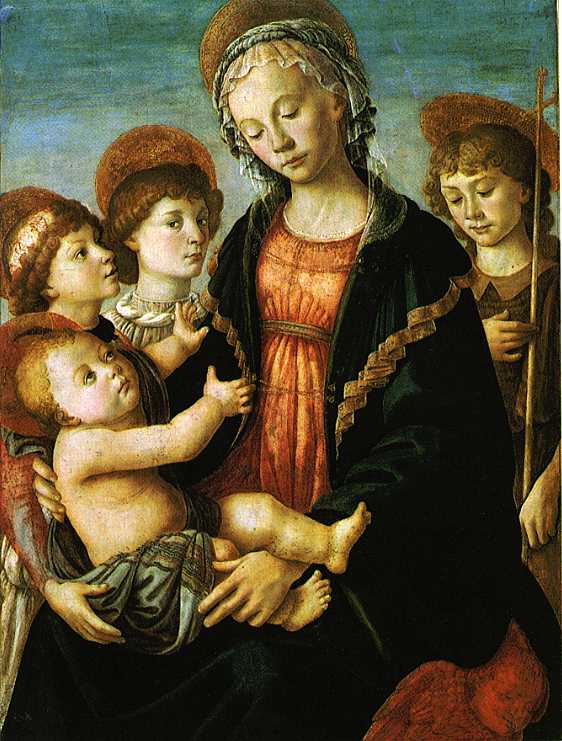

Madone
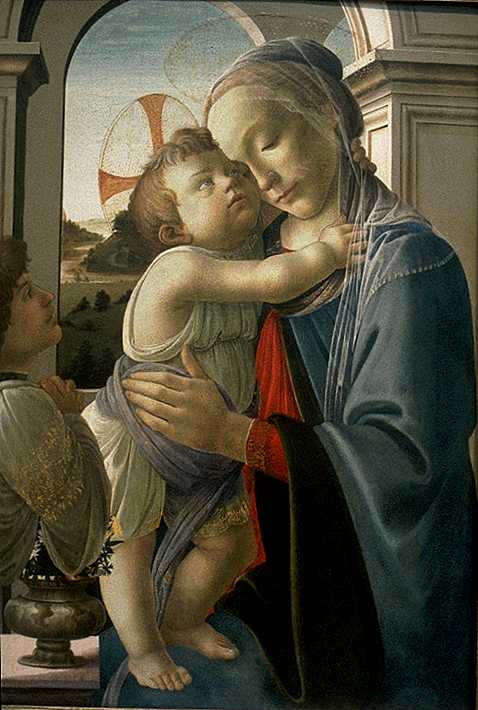

Small Madonna for a donor
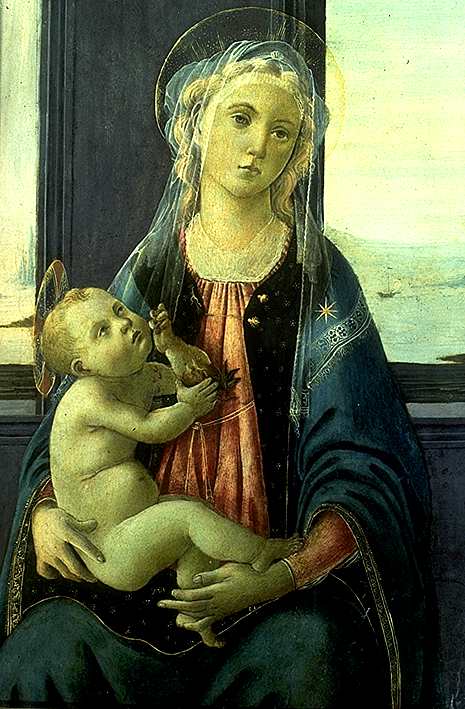

Madonna of the Sea
The Florentines who were commissioning these Madonnas were becoming more and more striking and acquiring more and more power. They wanted items which were more and more extraordinary, always larger and more beautiful. These young artists were pressured - each work had to be more magnificent than the last. The programs increased, always a Madonna with a Child, more persons were portrayed and fit perfectly in the round form, the tondo, a format which was very popular in Florence during the second half of the Quatrocento. Here is one of the first: :
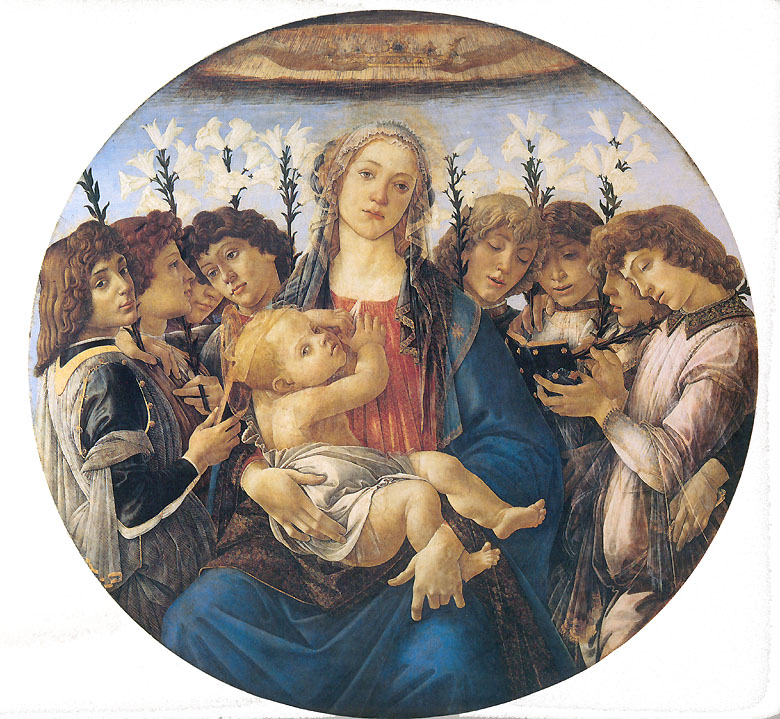

Tondo with Eight Angels
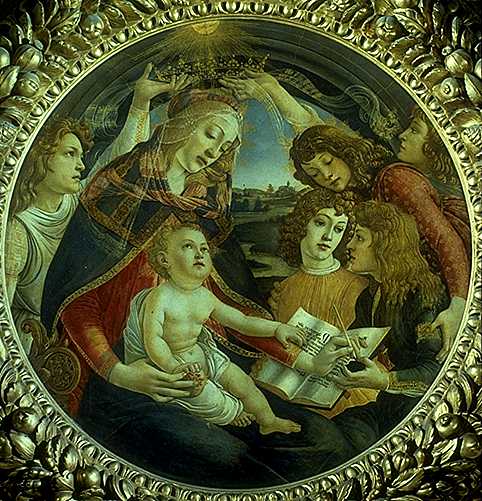

Tondo of the Magnificat
But one day, Botticelli said: "No more Madonnas!" - or one can at least imagine him saying that. This is very curious as the Virgin of the Magnificat was the last of a very long series which marked the entire preparatory stage. One might think that Botticelli now felt that he had the means to really be reborn and the means to exist at the same time. He thus abandoned what was for him an exercise in style, the Virgin and Child and only came back to it much later and in a completely different manner: he devoted himself to a new subject, which was basically an "enriched" Virgin and Child, that is, the Adoration of the Magi. monomaniacally with the subject of the Adoration of the Magi. Last Tuesday, we saw that the Adoration of the Magi was a perfect subject for the Florentines, who were rich, prosperous and owned the most beautiful things on the planet - the Magi are their mirror image. Creating luxurious paintings of the procession of Magi was to pay homage to the reigning families. When Benozzo Gozzoli painted his famous Procession of the Wise Kings, he was paying homage to the Medicis.
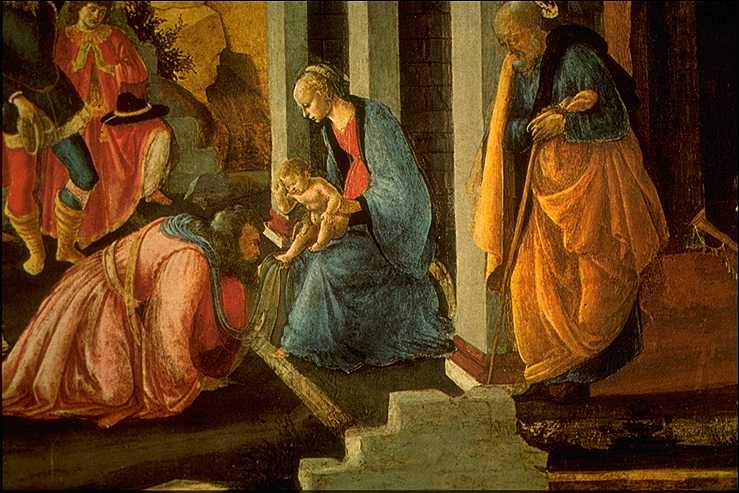
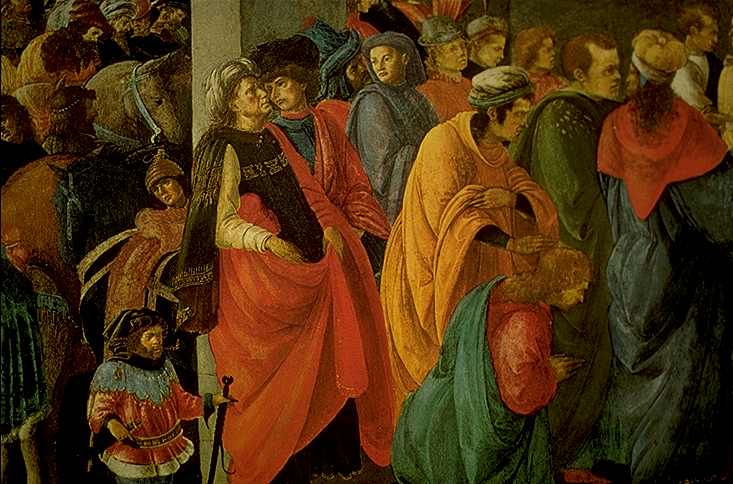

Adoration des Mages
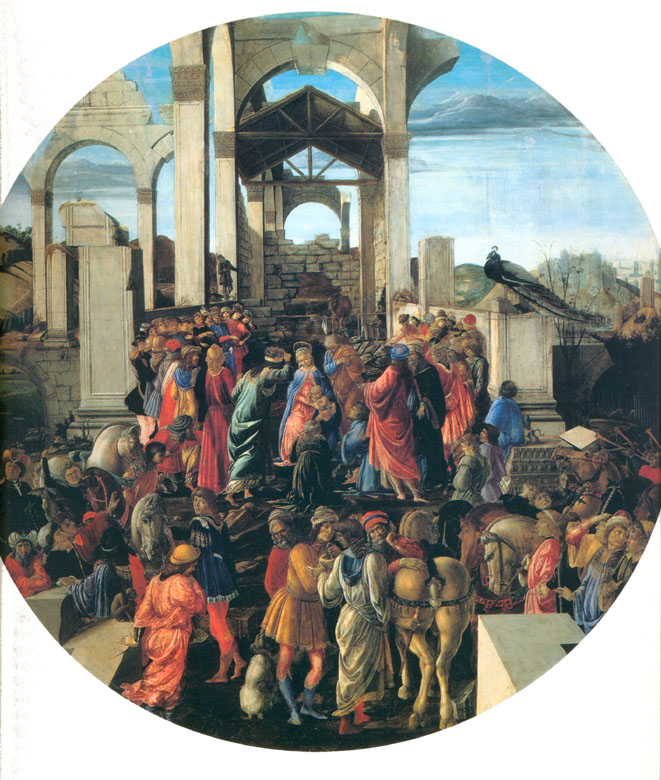

Adoration of the Magi
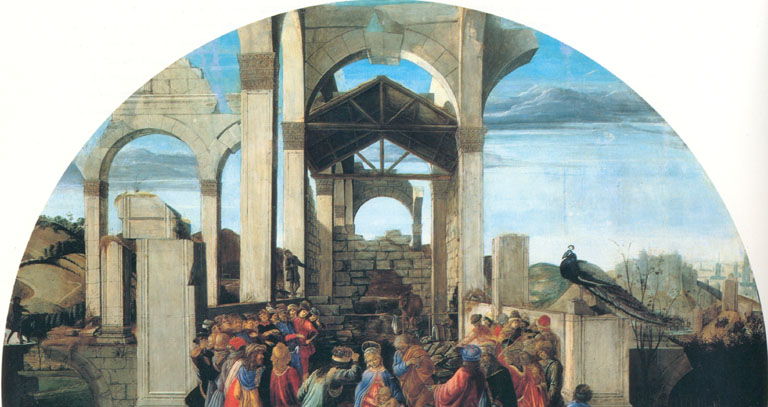
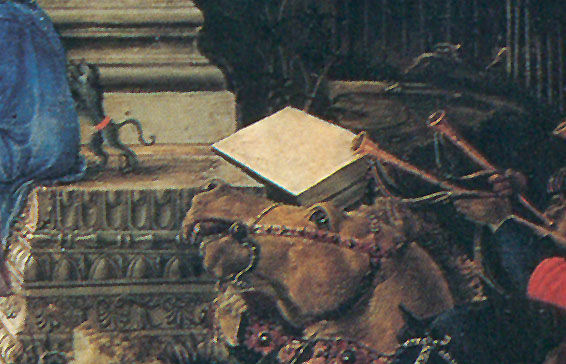
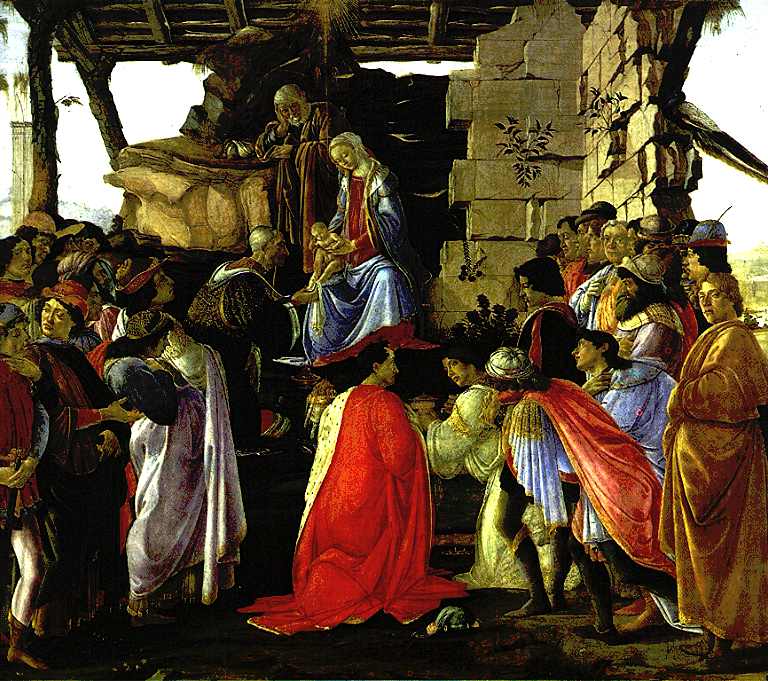

Adoration of the Mag
We have nearly finished with the religious works, but there are still two or three important points to be raised. Let's take a look as the following work: it's the famous.
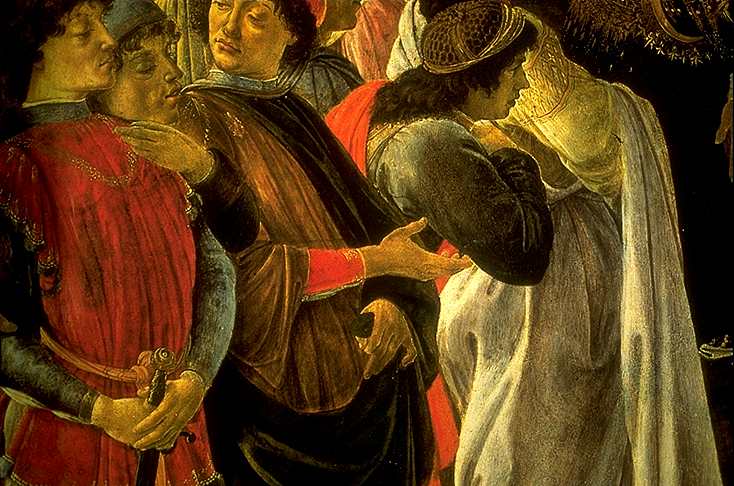
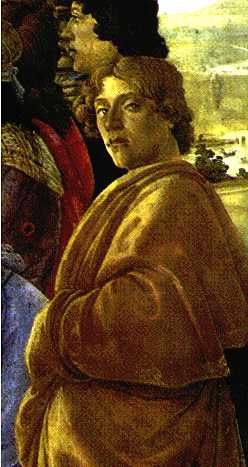
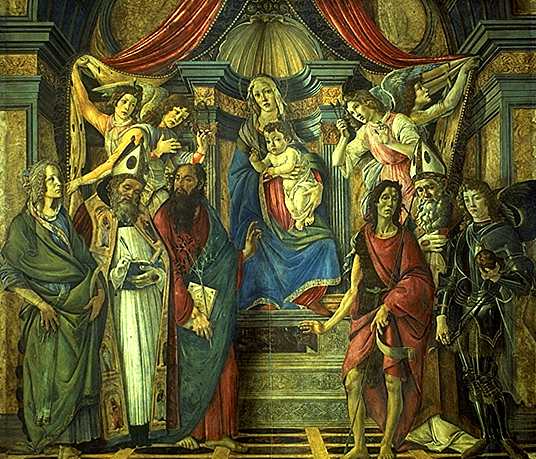

Saint Barnabas Altarpiece
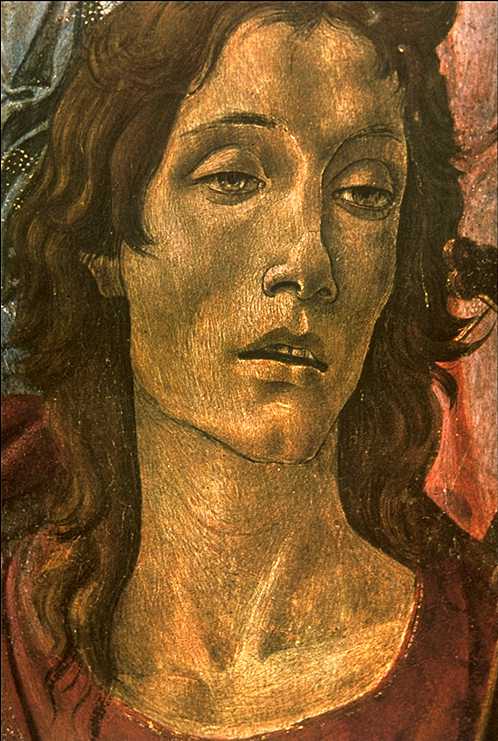


The Mystic Nativity
A study of this work, which was long thought to be eccentric, proved to be a revelation. Botticelli's maturity coincided exactly with the era of what was perhaps the century's greatest preacher: Savonarola. We must keep in mind that in the famous Lent sermon in 1499, a few days before Botticelli started this painting, Savonarola had told the Florentines: "Repent of what you have done, repent of your sins, distance yourself from the Demon, let yourself be won over by the angels, the only ones who can bring you to the Savior". This was only the framework, for Savonarola, as always, used all sorts of more explicit and more architectonic symbols. And the more we study the sermon and the work, the more we become aware that the work is, in effect, an illustration of the sermon. The circle of twelve angels corresponds to the twelve hours of the day and the twelve months of the year and can be found in Savonarola's words. The presence of the angels, who represent faith, hope and charity in white, red and green robes, were named by Savonarola. The angels, the same ones, in green, red and white, who come to save the humans by pulling them out of limbo, are again from Savonarola. The expelled demons, and we can see some here and there, are again from Savonarola. To put it simply, we realize that after a period of very esthetic Christianity, that of the first Virgins, the first tondos and what might be called the very social Christianity of the great Adorations, there was suddenly a signal event in Botticelli's career: the discovery of Savonarola. Botticelli's most inspired work is The Mystic Nativity, the last work of this first branch which we wanted to present to you tonight. We shall, moreover, have the chance, after having admired the pagan works, to see if "Savonarolism" was very important or only episodically significant to Botticelli, if it does or does not explicate the body of his work.
Details: angels crowned with laurels because they listened to Savonarola, urged on by the red, green and blue angels toward the Nativity are the right-hand group. In the center, an astonishing mbrace of this angel and this Gentile, who are separating from one another, enabling us to clearly see the Devil trying to slip under a flagstone. A magnificent double movement, nearly a triumphal arch marking this composition's central focus.
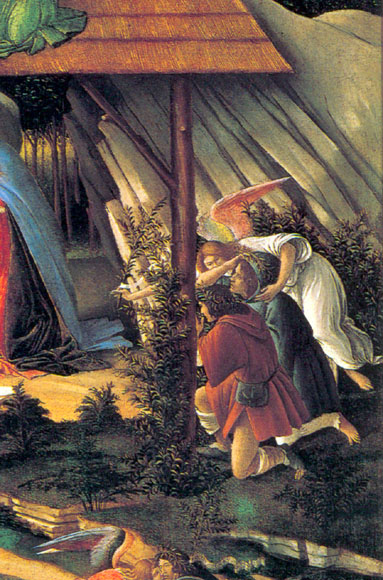
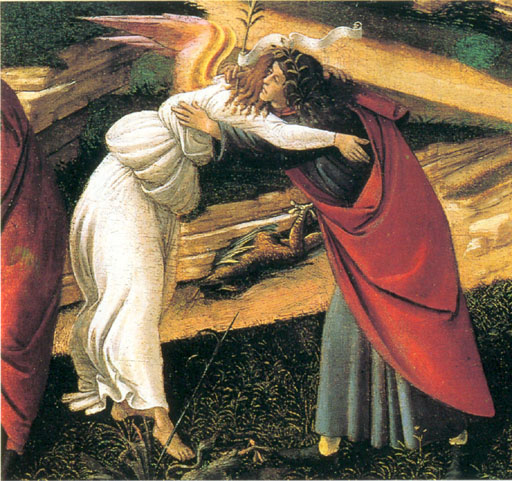 We shall now leave this Christian world to go on to the paintings of the pagan world, perhaps the most famous.
We shall now leave this Christian world to go on to the paintings of the pagan world, perhaps the most famous.
Christian inspiration
profane works
Here are these works, save, of course, for Giuliano's standard which has been lost.


Pallas Athene taming a Centaur
A very large work preserved in the Ufizzi in Florence. We are perfectly aware of the commission's circumstances: Lorenzo the Magnificent gave this work to a person called Lorenzo di Pierfrancesco de' Medici.
Lorenzo had just gotten married, and he married a woman with the most beautiful name in the world: Semiramis d'Appiamo. This is a name which had not yet reached the popularity which it would attain in the 16th century. This brilliant and superbly painted work was created for the marriage, and it was thus dictated by the circumstances. Lorenzo the Magnificent wanted the work to be a moral one, as he knew Lorenzo di Pierfrancesco to be sensual, brutal, debauched and violent, and a certain number of his servants had already been dispatched ad patres... As to his servants' wives, each of them bore him at least six children. He was something of a medieval lord. Semiramis d'Appiamo was supposed to restrain him. Rather rashly, Lorenzo the Magnificent was trying to say: Semiramis is Pallas, Reason which will triumph over bestiality, incarnated here by the centaur. It was a beautiful gift, a lovely painting to hang over the fireplace, but it was, above all, a lesson in morality: "Let your wife teach you and bring you back to Reason". That is the goal of this, Botticelli's first allegory.
Details:Pallas , is the sister of the Graces in the Lemmi Villa, as well as Jethro's daughters in the Sistine Chapel with both the same length and languor, admirably rendered. In addition, to make sure that Pierfrancesco realized immediately who had given him the gift, Semiramis wore a dress, embroidered with Lorenzo the Magnificent's insignia: three or four diamond rings, depending on the location. On the dress' detail, the three rings indicate the Magnificent's affiliation with this work, of which he seemingly dictated the subject matter.



Mars and Venus
This is a marriage commission from the Vespucci family. In these Florentine families, the important moment of the marriage was the day before, when the bride's dowry was exhibited in front of the house - silverware, gilded silver and jewels - in caskets which became more and more ornate and extravagant and which were called "cassones". As the 15th and 16th centuries went by, the caskets became monuments and the greatest artists would be asked to decorate them. Botticelli would be commissioned to paint this one for a Vespucci marriage. This work's strange format, its dimension of length, somewhat in the shape of the base of an altarpiece, is thus the result of the fact that it was the front of a "cassone".
Once again, the subject is philosophical rather than mythological. It should be noted that in passing from the first painting to the second and, even more so in passing from the second to the third, that the myths of Antiquity are not used anecdotally or for their folklore, nor for the liberty that one could afford in the details, but really more and more in a philosophical vein. In this painting, we are shown the young bride, depicted as Venus, contemplating her young husband, depicted as Mars, as he sleeps. Venus is Love and Harmony, Mars is War and Discord. Human nature consists of these two things, and the union of Venus and Mars could only create a balance of these forces and, thus, perfection. These Neo-Platonic lessons in morality which Botticelli delivers here were dictated by the patron. There is a very pretty small detail - small satyrs have stolen Mars' weapons and are playing at war in the background. We know that this is a Vespucci commission, as there are wasps coming out of the stump; "vespe" means wasp in Italian, and "vespi" are present in the Vespucci coat of arms.


 Botticelli's first insolently superb affirmation of pagan beauty can be found in the image of this admirable, bodiless Venus a - the body has been replaced by an extremely subtle play of the finest cloths and, at the same time, this braid which contains and reveals them. On the other side, one of Botticelli's first heroic nudes, this Mars with his drowsy features and the light on his face, which all Florence came to see. The patches of light on his face makes his sleep even deeper. This manner of sculpting a face with patches of sunlight, in the true sense of the term, was very new and remarked upon in Florence at that time. To show how well Botticelli could paint down to smallest detail, here is the little satyr who has gotten hold of Mars' helmet.
In any event, this work caused a lot of commotion, so much commotion that the noisiest of the Florentines, the famous Lorenzo de Pierfrancesco de' Medici, in the desire to make his villa more beautiful than it had ever been, commissioned two new paintings from Botticelli.
Botticelli's first insolently superb affirmation of pagan beauty can be found in the image of this admirable, bodiless Venus a - the body has been replaced by an extremely subtle play of the finest cloths and, at the same time, this braid which contains and reveals them. On the other side, one of Botticelli's first heroic nudes, this Mars with his drowsy features and the light on his face, which all Florence came to see. The patches of light on his face makes his sleep even deeper. This manner of sculpting a face with patches of sunlight, in the true sense of the term, was very new and remarked upon in Florence at that time. To show how well Botticelli could paint down to smallest detail, here is the little satyr who has gotten hold of Mars' helmet.
In any event, this work caused a lot of commotion, so much commotion that the noisiest of the Florentines, the famous Lorenzo de Pierfrancesco de' Medici, in the desire to make his villa more beautiful than it had ever been, commissioned two new paintings from Botticelli.


Pallas Athene taming a Centaur
Lorenzo di Pierfrancesco de' Medici
All the Medicis are descended from the same branch, that of Giovanni de' Medici, the first Gonfalonier of Florence, but who is not part of the adventures of the House of Medici. This Giovanni had two sons, one is Cosimo, the other, Lorenzo.Cosimo is the forebear of the famous senior branch, the one we have been discussing up to now: Cosimo the Elder, Piero the Gouty, Lorenzo the Magnificent , Piero the Reprobate, etc.
With respect to the junior branch, Lorenzo also had descendants: Gianpietro, who then fathered Lorenzo and Giovanni, etc. The latter Giovanni would become the First Grand Duke of Tuscany.
All the Medici family's grandeur was generated by the senior branch, which died out after Lorenzo the Magnificent's grandson died without descendants. Its power was then passed on to the junior branch when they ceased using the title of "Primo" of Florence to take on the more glorious title of Grand Duke of Florence and, later, Grand Duke of Tuscany. Lorenzo di Pierfrancesco de' Medici is from the junior branch which, historically, held the throne the longest. Members of this branch include Cosimo I as well as Catherine de Medicis, Marie de Medicis and so on.
With respect to the junior branch, Lorenzo also had descendants: Gianpietro, who then fathered Lorenzo and Giovanni, etc. The latter Giovanni would become the First Grand Duke of Tuscany.
All the Medici family's grandeur was generated by the senior branch, which died out after Lorenzo the Magnificent's grandson died without descendants. Its power was then passed on to the junior branch when they ceased using the title of "Primo" of Florence to take on the more glorious title of Grand Duke of Florence and, later, Grand Duke of Tuscany. Lorenzo di Pierfrancesco de' Medici is from the junior branch which, historically, held the throne the longest. Members of this branch include Cosimo I as well as Catherine de Medicis, Marie de Medicis and so on.
Lorenzo di Pierfrancesco de' Medici
Lorenzo had just gotten married, and he married a woman with the most beautiful name in the world: Semiramis d'Appiamo. This is a name which had not yet reached the popularity which it would attain in the 16th century. This brilliant and superbly painted work was created for the marriage, and it was thus dictated by the circumstances. Lorenzo the Magnificent wanted the work to be a moral one, as he knew Lorenzo di Pierfrancesco to be sensual, brutal, debauched and violent, and a certain number of his servants had already been dispatched ad patres... As to his servants' wives, each of them bore him at least six children. He was something of a medieval lord. Semiramis d'Appiamo was supposed to restrain him. Rather rashly, Lorenzo the Magnificent was trying to say: Semiramis is Pallas, Reason which will triumph over bestiality, incarnated here by the centaur. It was a beautiful gift, a lovely painting to hang over the fireplace, but it was, above all, a lesson in morality: "Let your wife teach you and bring you back to Reason". That is the goal of this, Botticelli's first allegory.
Details:Pallas , is the sister of the Graces in the Lemmi Villa, as well as Jethro's daughters in the Sistine Chapel with both the same length and languor, admirably rendered. In addition, to make sure that Pierfrancesco realized immediately who had given him the gift, Semiramis wore a dress, embroidered with Lorenzo the Magnificent's insignia: three or four diamond rings, depending on the location. On the dress' detail, the three rings indicate the Magnificent's affiliation with this work, of which he seemingly dictated the subject matter.
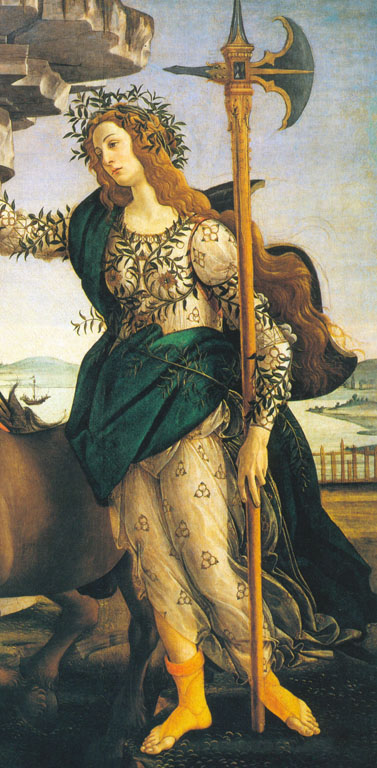
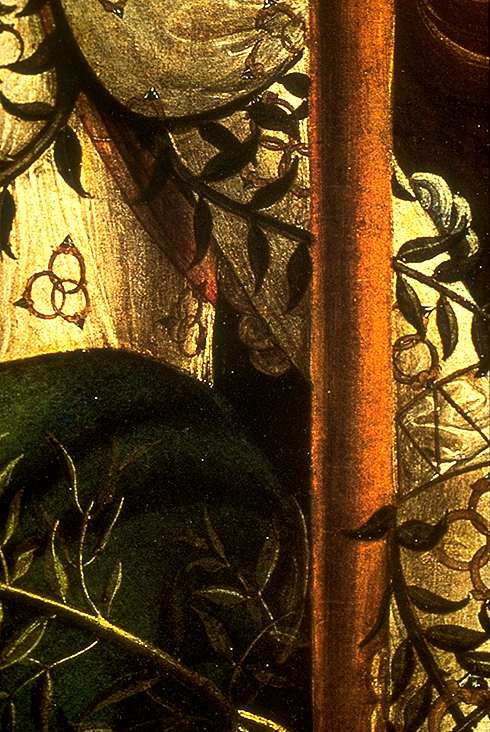
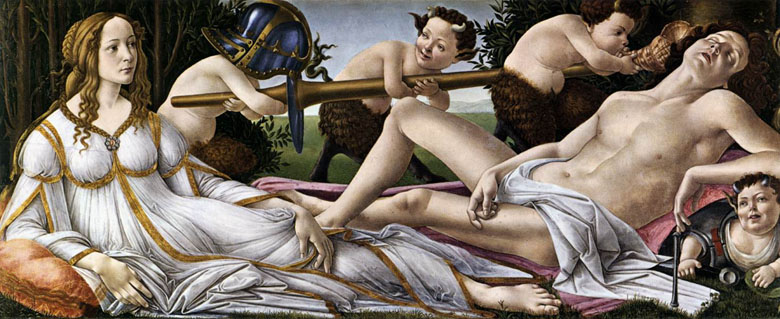

Mars and Venus
Once again, the subject is philosophical rather than mythological. It should be noted that in passing from the first painting to the second and, even more so in passing from the second to the third, that the myths of Antiquity are not used anecdotally or for their folklore, nor for the liberty that one could afford in the details, but really more and more in a philosophical vein. In this painting, we are shown the young bride, depicted as Venus, contemplating her young husband, depicted as Mars, as he sleeps. Venus is Love and Harmony, Mars is War and Discord. Human nature consists of these two things, and the union of Venus and Mars could only create a balance of these forces and, thus, perfection. These Neo-Platonic lessons in morality which Botticelli delivers here were dictated by the patron. There is a very pretty small detail - small satyrs have stolen Mars' weapons and are playing at war in the background. We know that this is a Vespucci commission, as there are wasps coming out of the stump; "vespe" means wasp in Italian, and "vespi" are present in the Vespucci coat of arms.
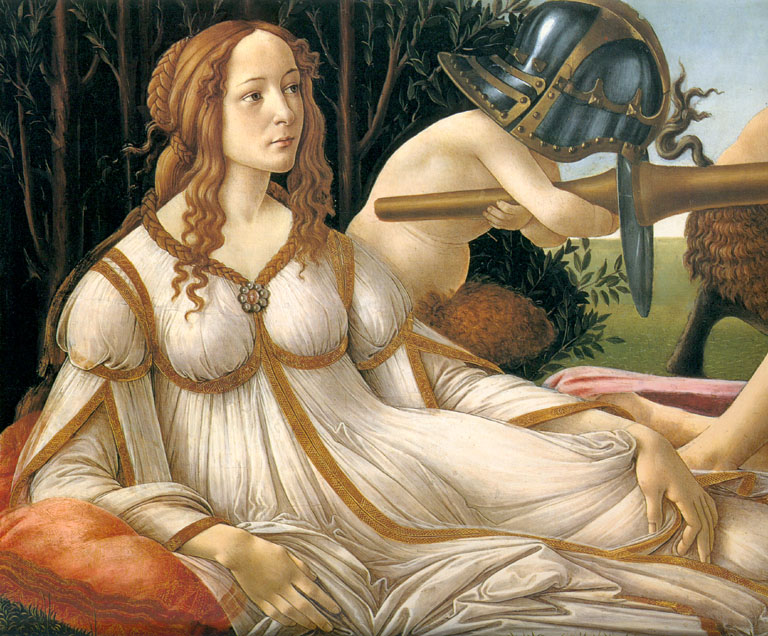
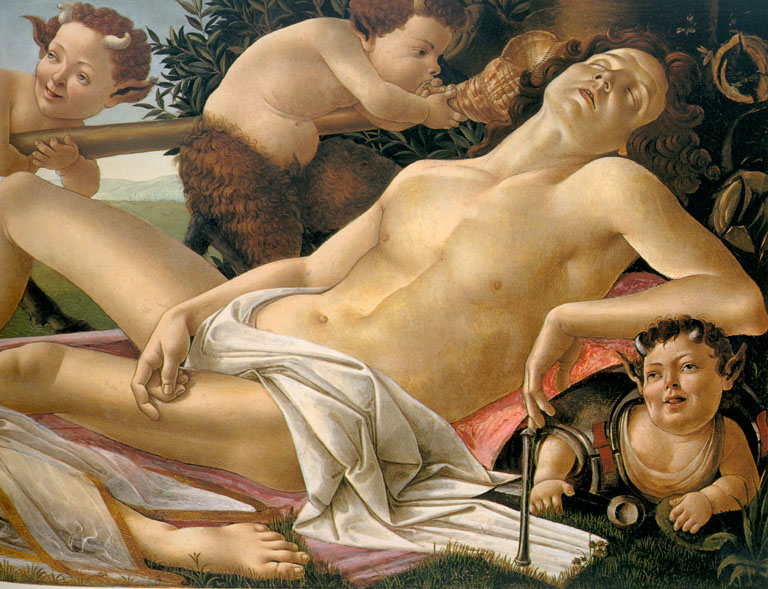
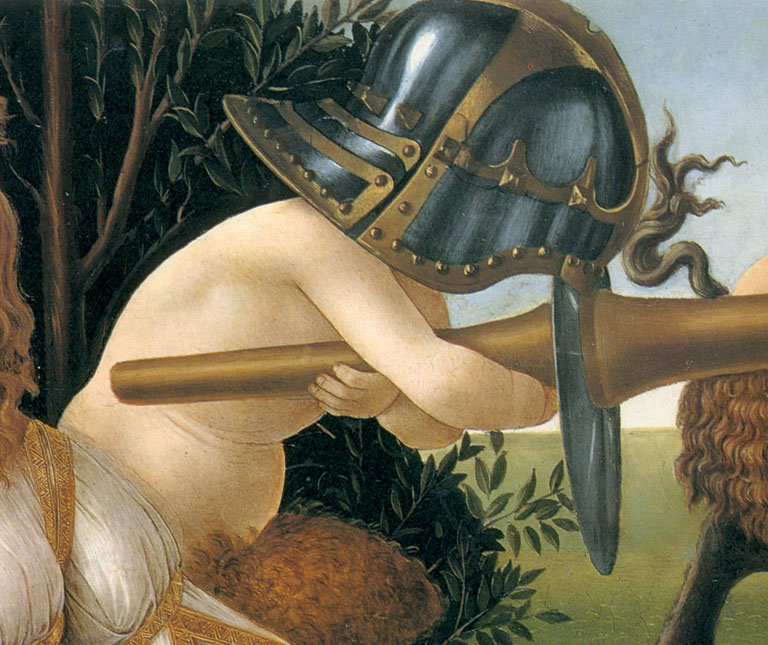 Botticelli's first insolently superb affirmation of pagan beauty can be found in the image of this admirable, bodiless Venus a - the body has been replaced by an extremely subtle play of the finest cloths and, at the same time, this braid which contains and reveals them. On the other side, one of Botticelli's first heroic nudes, this Mars with his drowsy features and the light on his face, which all Florence came to see. The patches of light on his face makes his sleep even deeper. This manner of sculpting a face with patches of sunlight, in the true sense of the term, was very new and remarked upon in Florence at that time. To show how well Botticelli could paint down to smallest detail, here is the little satyr who has gotten hold of Mars' helmet.
In any event, this work caused a lot of commotion, so much commotion that the noisiest of the Florentines, the famous Lorenzo de Pierfrancesco de' Medici, in the desire to make his villa more beautiful than it had ever been, commissioned two new paintings from Botticelli.
Botticelli's first insolently superb affirmation of pagan beauty can be found in the image of this admirable, bodiless Venus a - the body has been replaced by an extremely subtle play of the finest cloths and, at the same time, this braid which contains and reveals them. On the other side, one of Botticelli's first heroic nudes, this Mars with his drowsy features and the light on his face, which all Florence came to see. The patches of light on his face makes his sleep even deeper. This manner of sculpting a face with patches of sunlight, in the true sense of the term, was very new and remarked upon in Florence at that time. To show how well Botticelli could paint down to smallest detail, here is the little satyr who has gotten hold of Mars' helmet.
In any event, this work caused a lot of commotion, so much commotion that the noisiest of the Florentines, the famous Lorenzo de Pierfrancesco de' Medici, in the desire to make his villa more beautiful than it had ever been, commissioned two new paintings from Botticelli.
profane works


A study of this work, which was long thought to be eccentric, proved to be a revelation. Botticelli's maturity coincided exactly with the era of what was perhaps the century's greatest preacher: Savonarola. We must keep in mind that in the famous Lent sermon in 1499, a few days before Botticelli started this painting, Savonarola had told the Florentines: "Repent of what you have done, repent of your sins, distance yourself from the Demon, let yourself be won over by the angels, the only ones who can bring you to the Savior". This was only the framework, for Savonarola, as always, used all sorts of more explicit and more architectonic symbols. And the more we study the sermon and the work, the more we become aware that the work is, in effect, an illustration of the sermon. The circle of twelve angels corresponds to the twelve hours of the day and the twelve months of the year and can be found in Savonarola's words. The presence of the angels, who represent faith, hope and charity in white, red and green robes, were named by Savonarola. The angels, the same ones, in green, red and white, who come to save the humans by pulling them out of limbo, are again from Savonarola. The expelled demons, and we can see some here and there, are again from Savonarola. To put it simply, we realize that after a period of very esthetic Christianity, that of the first Virgins, the first tondos and what might be called the very social Christianity of the great Adorations, there was suddenly a signal event in Botticelli's career: the discovery of Savonarola. Botticelli's most inspired work is The Mystic Nativity, the last work of this first branch which we wanted to present to you tonight. We shall, moreover, have the chance, after having admired the pagan works, to see if "Savonarolism" was very important or only episodically significant to Botticelli, if it does or does not explicate the body of his work.

 Details: angess crowned with laurels because they listened to Savonarola, urged on by the red, green and blue angels toward the Nativity are the right-hand group. In the center, an astonishing embrace of this angel and this Gentile who are separating from one another, enabling us to clearly see the Devil trying to slip under a flagstone. A magnificent double movement, nearly a triumphal arch marking this composition's central focus.
Details: angess crowned with laurels because they listened to Savonarola, urged on by the red, green and blue angels toward the Nativity are the right-hand group. In the center, an astonishing embrace of this angel and this Gentile who are separating from one another, enabling us to clearly see the Devil trying to slip under a flagstone. A magnificent double movement, nearly a triumphal arch marking this composition's central focus.
Until the 1920's, all the writers, authors and art historians considered these two paintings to be two distinct works, because one of the paintings is 37 cm smaller than the other. It was thought that the first painting had been commissioned and, as it was pretty, the second one was then commissioned. The more we look at these paintings, the more we realize, with absolute certainty, that these paintings were made to be with one another, side by side, if not one in the other. Not only their pictorial style, but also the artist's intention match: one lays the groundwork for the other. With today's techniques, the works were reexamined, and it was revealed that 32.5 cm of the top of the Birth of Venus had been planed down, creating this size disparity which, even today, means that the Ufizi's curators don't dare put them side by side, even though they were made to be together. These are works which contain a message which we shall decipher together, intellectual progress which we shall see together, while we admire the beauty of Botticelli's painting.
It should be recalled that we are in Florence of the 1480's where artists clustered around the princes, the Medicis in particular, but also the Vespuccis, the Tornabuonis, etc., Botticelli and the others as well as the humanists This new race of humanists cannot be forgotten, these men of science whose mission was to make the past live again, to translate Virgil, Homer, Hesiod and Pindar and to update them. These humanists were surrounded by their disciples, the great thinkers and philosophers, and all these people lived together. Every day, Lorenzo the Magnificent assembled these humanists and artists and, together, much like a literary society led by Prince Apollo, the art of Florence was created, and the humanists' ideas were then translated by the artists, painters, sculptors, goldsmiths and musicians. Several generations later, musical Neo-Platonism was born. We know that this Birth of Venus and Spring, which is its direct continuation, was launched as an idea by Lorenzo the Magnificent himself, set to verse by his favorite humanist, Ange Poliziano, interpreted by the tiny genius, Pico della Mirandola, approved by the patriarch, Marsilio Ficino, and the notebook was wrapped up for delivery to Botticelli. It went from Lorenzo the Magnificent to all of Florence's humanism of this second half of the 15th century to finally be given to Botticelli, who thus scrupulously followed a text: the profane Birth of Venus and the coronation of the sacred Venus. It was written by Ange Poliziano, based on an ode by Hesiod, and the work was, in fact, paid for by Lorenzo di Pierfrancesco. We shall now see the two paintings, but one can only hope that, one day, they will be arranged side by side so that they can be shown on a single slide.
The Birth of Venus We see the story's birth with the winds, Zephyr and Aura, who, on the first day of Creation, elevated this shell bearing Venus' triumphant nudity from the unknown depths of the sea. And, approaching the earth on which she will assume her true role, her true power, she is suddenly modest, and we should note the stance, which Botticelli borrowed directly from the beautiful examples of the antique Venus Pudicae that were being discovered at that time. He really painted her like a Venus Pudica. For this modesty to take on its sacred nature, one of the Graces, in the name of all three, is there to cover her with her cape.
The Graces have the privilege of covering Venus' nudity and transforming her into the mother and patron saint of all the forces of creation. Venus is in the process of landing. It should be pointed out that the shore she is landing on is very rugged and already has tall trees, both laurel and myrtle, and that the trees are crowded together, their foliage obscuring one another.

Here are several details to make us aware of Venus' triumphant splendor. We know that until recently, this Birth of Venus had been lavishly covered with varnish, which means that the successive coats of varnish had finally completely opacified. The two paintings were superbly cleaned, and we have now discovered a new Botticelli: pearly flesh, nearly translucent, skin so fine that we have the impression that we can almost see the sea through it. All of the marvelous qualities of Botticelli's painting only appeared after it had been cleaned.


 This is the heroic group of winds.. In fact, in their disorder, they represent the original chaos, as Venus was born from this chaos which thus pushed her to take over the world. An admirable Grace with the cape which she has prepared to cover Venus with the flowers and fruits of the earth, as she shall become Venus Flora and Pomona. She will be all that and, as the sacred Venus, she will be the mistress of the gods and goddesses of Olympus. This Grace has a superb face, which Ingres had always maintained was the most beautiful face ever painted (he always liked chinless women).
This is the heroic group of winds.. In fact, in their disorder, they represent the original chaos, as Venus was born from this chaos which thus pushed her to take over the world. An admirable Grace with the cape which she has prepared to cover Venus with the flowers and fruits of the earth, as she shall become Venus Flora and Pomona. She will be all that and, as the sacred Venus, she will be the mistress of the gods and goddesses of Olympus. This Grace has a superb face, which Ingres had always maintained was the most beautiful face ever painted (he always liked chinless women).
 The apparent movement in the light of the white dress covered with cornflowers does not come from its folds, but rather from the play of the cornflowers' blues, the sunlit parts, the shaded parts, the parts in the foreground, the parts in the background all sculpted by the cornflowers covering these fields which cause the beauty of this Grace's body to dominate the painting, who is one of the most beautiful parts of the Birth of Venus.
The apparent movement in the light of the white dress covered with cornflowers does not come from its folds, but rather from the play of the cornflowers' blues, the sunlit parts, the shaded parts, the parts in the foreground, the parts in the background all sculpted by the cornflowers covering these fields which cause the beauty of this Grace's body to dominate the painting, who is one of the most beautiful parts of the Birth of Venus.
Spring From the start, it should be pointed out that this is the same forest, the same trees, the same foliage, the same spacing between the trees, the same land, the same ground, the same flower patches. In other words, Venus was born and landed in this second painting which is Spring - it is the continuation. We still find her as the composition's central focus, but dressed as a sovereign. From the profane Venus we saw earlier, nude, we now progress to the sacred Venus, dressed as a matron in the noblest sense of the term. As such, she is truly the patron saint of the forces and elements and is surrounded by everything she needs to triumph over the twelve months of the year, the four seasons and, thus, eternity.
Mercury extends his caduceus to stop the wind which had been blowing earlier with Zephyr and his brother and, at the same time, stops winter from becoming spring. The striking group of the three Graces, perhaps the most beautiful ever painted, is the affirmation of Primavera, that is, Spring, which Venus is still facing. Then time passes, and we see the affirmation of summer, represented here by Flora, whose robe is now, so to speak, made of flowers and who is strewing flowers, the product of her generosity, on the ground. And autumn by Chloe, who is nearly timidly turned toward a blue and somewhat terrifying character who is trying to catch her. This character is Zephyr who, at one time, forgot to blow, because he was chasing the nymph, Chloe through the woods.

What is absolutely extraordinary, if one thinks back to the Birth, is that we have Zephyr, Venus and a Grace in the first painting, and here, we have Mercury, the Graces, Venus, Flora, Chloe and Zephyr. It all begins and ends with Zephyr; the two paintings thus form a complete cycle of seasons - winter, spring, summer and autumn. This was all done in order to show us nature's cycle which is so inherent to the Hesiodic Neo-Platonic inspiration for people such as Marsilio Ficino, Pico della Mirandola and others who dreamed of that period. But it also shows us the primacy of sacred love, as it is incarnated here, over profane love, over the fragility of the water and the shell in the preceding work. In fact, all the allusions could be studied at much greater length to show all the similarities between the two paintings. For the time being, let's take a walk through Spring.


 On the left, Mercure and the Graces and, above all, the very beautiful image of Mercury raising his caduceus to stop the clouds and the wind in order to allow the Graces to dance peacefully - nothing could be more beautiful. The robes appear to be transparent but aren't, as one can barely make out the bodies. The bodies are part of the dance, as the cloth really dances and the arm movements, in particular, are sublime. Then we have Venus in the center of the composition, in this nearly solemn pose she has assumed, a matron presiding over the year, as it develops with the character of Flora, one of the loveliest details of Spring, and Chloe and Zephyr, the last three characters whose dancing, here again, is the exact counterpoint to the group of the three Graces.
On the left, Mercure and the Graces and, above all, the very beautiful image of Mercury raising his caduceus to stop the clouds and the wind in order to allow the Graces to dance peacefully - nothing could be more beautiful. The robes appear to be transparent but aren't, as one can barely make out the bodies. The bodies are part of the dance, as the cloth really dances and the arm movements, in particular, are sublime. Then we have Venus in the center of the composition, in this nearly solemn pose she has assumed, a matron presiding over the year, as it develops with the character of Flora, one of the loveliest details of Spring, and Chloe and Zephyr, the last three characters whose dancing, here again, is the exact counterpoint to the group of the three Graces.




Details of Flora's face, the best-known in Botticelli's works, of Flora's robe which is like a rendering of the Grace's robe in the Birth of Venus. All of her movements are also the result of a deliberate distortion of the flowers and the bouquet of flowers she is preparing to throw to the world. Finally, Chloe, pursued by Zephyr who, in both instances has the same distended cheeks; in one case, he is blue, this is the winter Zephyr, in the other, the Birth of Venus, he is nearly yellow, this is the spring Zephyr.
Leaving these paintings which represent one of the heights of Botticelli's profane painting, we hope that we have succeeded in demonstrating the extent to which it responds to an iconographic program, the extent to which this program is a myth and the extent to which the myth is meant to educate us about the primacy of sacred love over profane love. It is paramount to be aware of this, as we can already note that in the Christian paintings, Botticelli never even tries to educate. On the other hand, in the pagan paintings, from Mars and Venus on and mostly with the Birth of Venus and Spring, we can see that there is an attempt at education. It is rather extraordinary to realize that Botticelli is more at ease in this mythical didactic role with the "pagan" gods than with his perennial Christianity.
It should be recalled that we are in Florence of the 1480's where artists clustered around the princes, the Medicis in particular, but also the Vespuccis, the Tornabuonis, etc., Botticelli and the others as well as the humanists This new race of humanists cannot be forgotten, these men of science whose mission was to make the past live again, to translate Virgil, Homer, Hesiod and Pindar and to update them. These humanists were surrounded by their disciples, the great thinkers and philosophers, and all these people lived together. Every day, Lorenzo the Magnificent assembled these humanists and artists and, together, much like a literary society led by Prince Apollo, the art of Florence was created, and the humanists' ideas were then translated by the artists, painters, sculptors, goldsmiths and musicians. Several generations later, musical Neo-Platonism was born. We know that this Birth of Venus and Spring, which is its direct continuation, was launched as an idea by Lorenzo the Magnificent himself, set to verse by his favorite humanist, Ange Poliziano, interpreted by the tiny genius, Pico della Mirandola, approved by the patriarch, Marsilio Ficino, and the notebook was wrapped up for delivery to Botticelli. It went from Lorenzo the Magnificent to all of Florence's humanism of this second half of the 15th century to finally be given to Botticelli, who thus scrupulously followed a text: the profane Birth of Venus and the coronation of the sacred Venus. It was written by Ange Poliziano, based on an ode by Hesiod, and the work was, in fact, paid for by Lorenzo di Pierfrancesco. We shall now see the two paintings, but one can only hope that, one day, they will be arranged side by side so that they can be shown on a single slide.
The Birth of Venus We see the story's birth with the winds, Zephyr and Aura, who, on the first day of Creation, elevated this shell bearing Venus' triumphant nudity from the unknown depths of the sea. And, approaching the earth on which she will assume her true role, her true power, she is suddenly modest, and we should note the stance, which Botticelli borrowed directly from the beautiful examples of the antique Venus Pudicae that were being discovered at that time. He really painted her like a Venus Pudica. For this modesty to take on its sacred nature, one of the Graces, in the name of all three, is there to cover her with her cape.
The Graces have the privilege of covering Venus' nudity and transforming her into the mother and patron saint of all the forces of creation. Venus is in the process of landing. It should be pointed out that the shore she is landing on is very rugged and already has tall trees, both laurel and myrtle, and that the trees are crowded together, their foliage obscuring one another.


Here are several details to make us aware of Venus' triumphant splendor. We know that until recently, this Birth of Venus had been lavishly covered with varnish, which means that the successive coats of varnish had finally completely opacified. The two paintings were superbly cleaned, and we have now discovered a new Botticelli: pearly flesh, nearly translucent, skin so fine that we have the impression that we can almost see the sea through it. All of the marvelous qualities of Botticelli's painting only appeared after it had been cleaned.
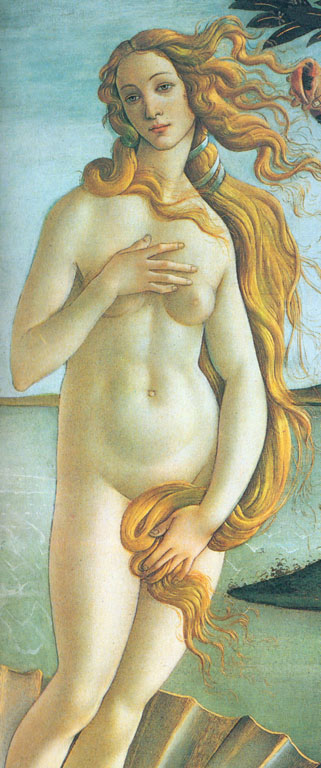
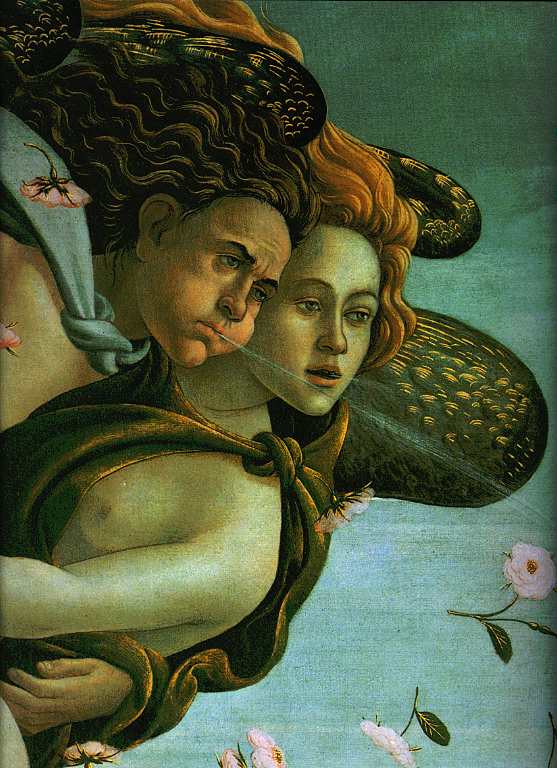
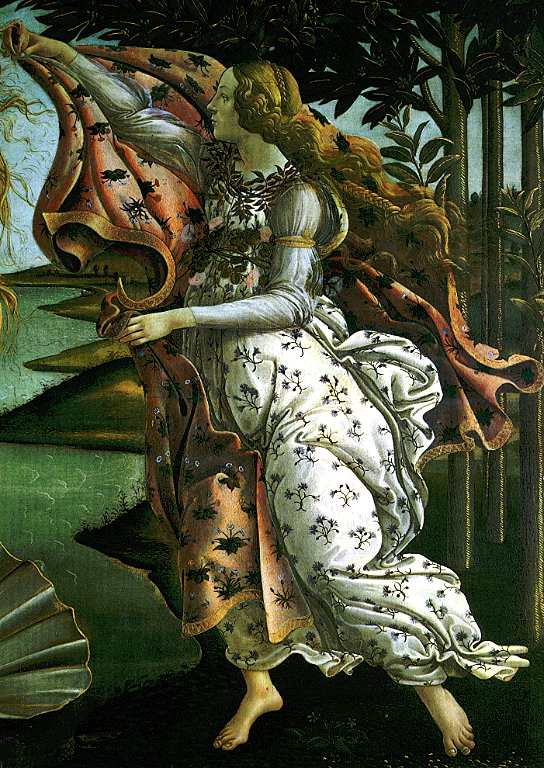 This is the heroic group of winds.. In fact, in their disorder, they represent the original chaos, as Venus was born from this chaos which thus pushed her to take over the world. An admirable Grace with the cape which she has prepared to cover Venus with the flowers and fruits of the earth, as she shall become Venus Flora and Pomona. She will be all that and, as the sacred Venus, she will be the mistress of the gods and goddesses of Olympus. This Grace has a superb face, which Ingres had always maintained was the most beautiful face ever painted (he always liked chinless women).
This is the heroic group of winds.. In fact, in their disorder, they represent the original chaos, as Venus was born from this chaos which thus pushed her to take over the world. An admirable Grace with the cape which she has prepared to cover Venus with the flowers and fruits of the earth, as she shall become Venus Flora and Pomona. She will be all that and, as the sacred Venus, she will be the mistress of the gods and goddesses of Olympus. This Grace has a superb face, which Ingres had always maintained was the most beautiful face ever painted (he always liked chinless women).
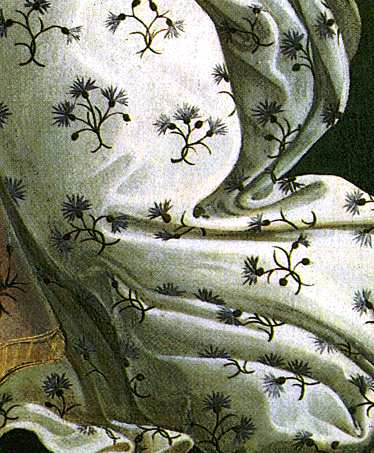 The apparent movement in the light of the white dress covered with cornflowers does not come from its folds, but rather from the play of the cornflowers' blues, the sunlit parts, the shaded parts, the parts in the foreground, the parts in the background all sculpted by the cornflowers covering these fields which cause the beauty of this Grace's body to dominate the painting, who is one of the most beautiful parts of the Birth of Venus.
The apparent movement in the light of the white dress covered with cornflowers does not come from its folds, but rather from the play of the cornflowers' blues, the sunlit parts, the shaded parts, the parts in the foreground, the parts in the background all sculpted by the cornflowers covering these fields which cause the beauty of this Grace's body to dominate the painting, who is one of the most beautiful parts of the Birth of Venus.
Spring From the start, it should be pointed out that this is the same forest, the same trees, the same foliage, the same spacing between the trees, the same land, the same ground, the same flower patches. In other words, Venus was born and landed in this second painting which is Spring - it is the continuation. We still find her as the composition's central focus, but dressed as a sovereign. From the profane Venus we saw earlier, nude, we now progress to the sacred Venus, dressed as a matron in the noblest sense of the term. As such, she is truly the patron saint of the forces and elements and is surrounded by everything she needs to triumph over the twelve months of the year, the four seasons and, thus, eternity.
Mercury extends his caduceus to stop the wind which had been blowing earlier with Zephyr and his brother and, at the same time, stops winter from becoming spring. The striking group of the three Graces, perhaps the most beautiful ever painted, is the affirmation of Primavera, that is, Spring, which Venus is still facing. Then time passes, and we see the affirmation of summer, represented here by Flora, whose robe is now, so to speak, made of flowers and who is strewing flowers, the product of her generosity, on the ground. And autumn by Chloe, who is nearly timidly turned toward a blue and somewhat terrifying character who is trying to catch her. This character is Zephyr who, at one time, forgot to blow, because he was chasing the nymph, Chloe through the woods.
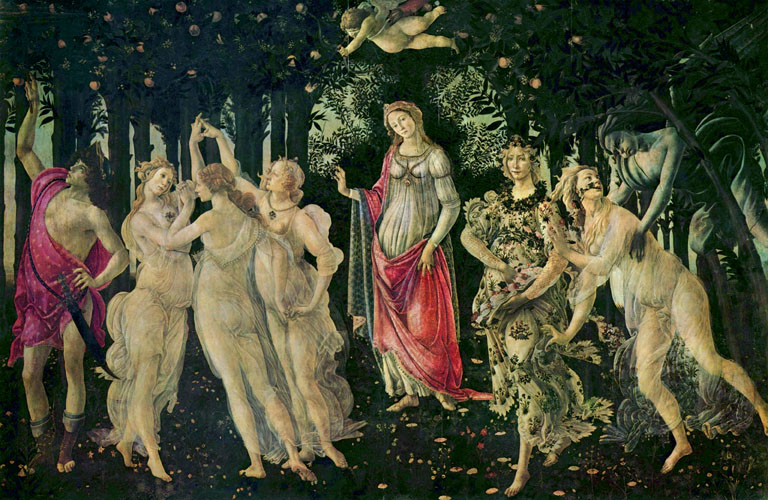

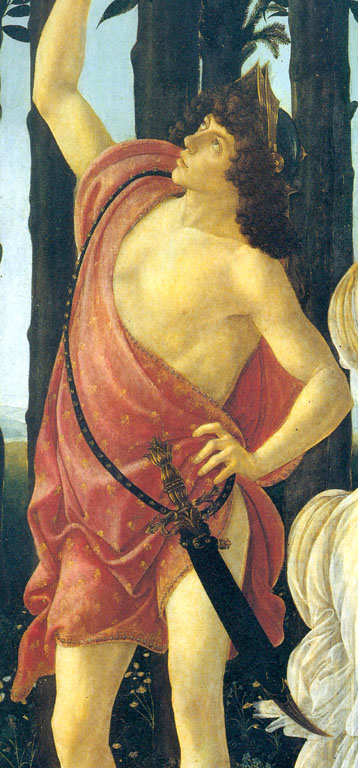
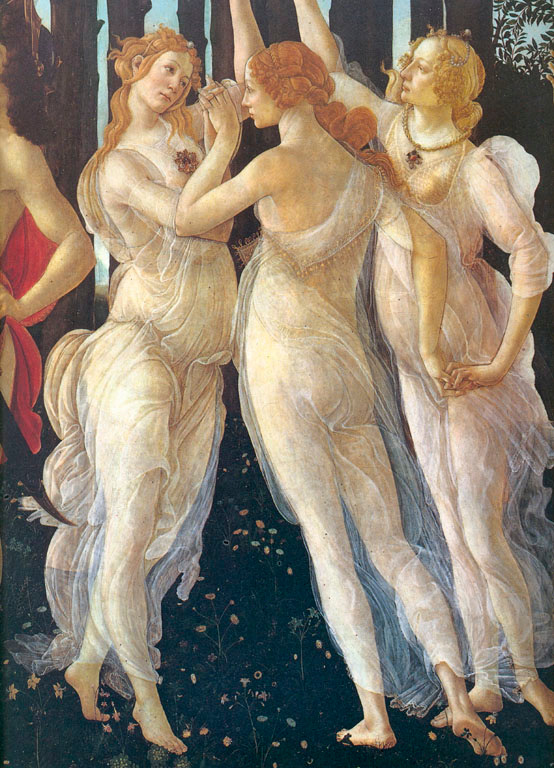
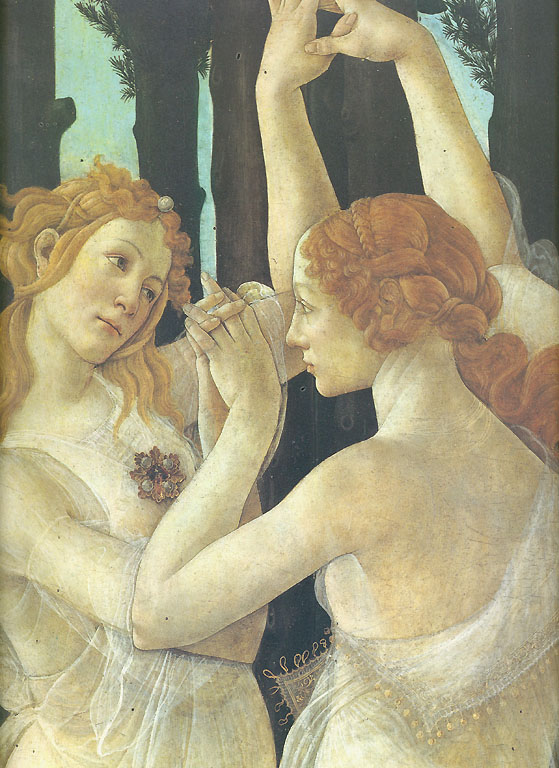 On the left, Mercure and the Graces and, above all, the very beautiful image of Mercury raising his caduceus to stop the clouds and the wind in order to allow the Graces to dance peacefully - nothing could be more beautiful. The robes appear to be transparent but aren't, as one can barely make out the bodies. The bodies are part of the dance, as the cloth really dances and the arm movements, in particular, are sublime. Then we have Venus in the center of the composition, in this nearly solemn pose she has assumed, a matron presiding over the year, as it develops with the character of Flora, one of the loveliest details of Spring, and Chloe and Zephyr, the last three characters whose dancing, here again, is the exact counterpoint to the group of the three Graces.
On the left, Mercure and the Graces and, above all, the very beautiful image of Mercury raising his caduceus to stop the clouds and the wind in order to allow the Graces to dance peacefully - nothing could be more beautiful. The robes appear to be transparent but aren't, as one can barely make out the bodies. The bodies are part of the dance, as the cloth really dances and the arm movements, in particular, are sublime. Then we have Venus in the center of the composition, in this nearly solemn pose she has assumed, a matron presiding over the year, as it develops with the character of Flora, one of the loveliest details of Spring, and Chloe and Zephyr, the last three characters whose dancing, here again, is the exact counterpoint to the group of the three Graces.
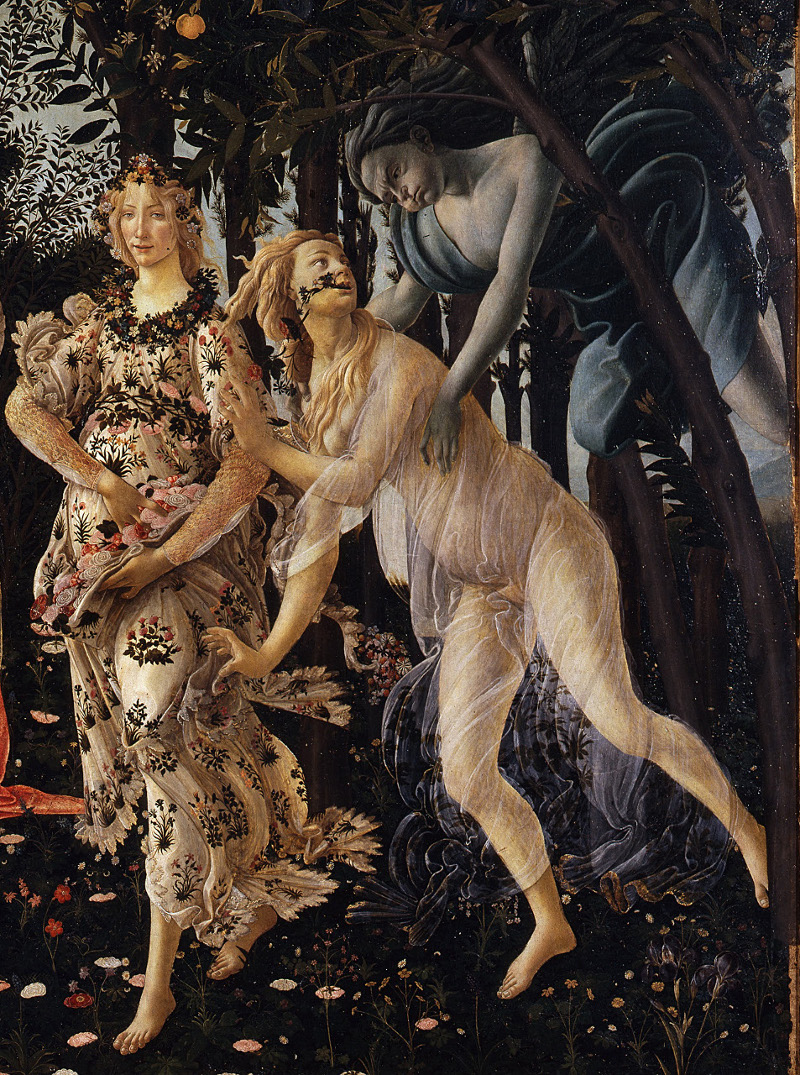
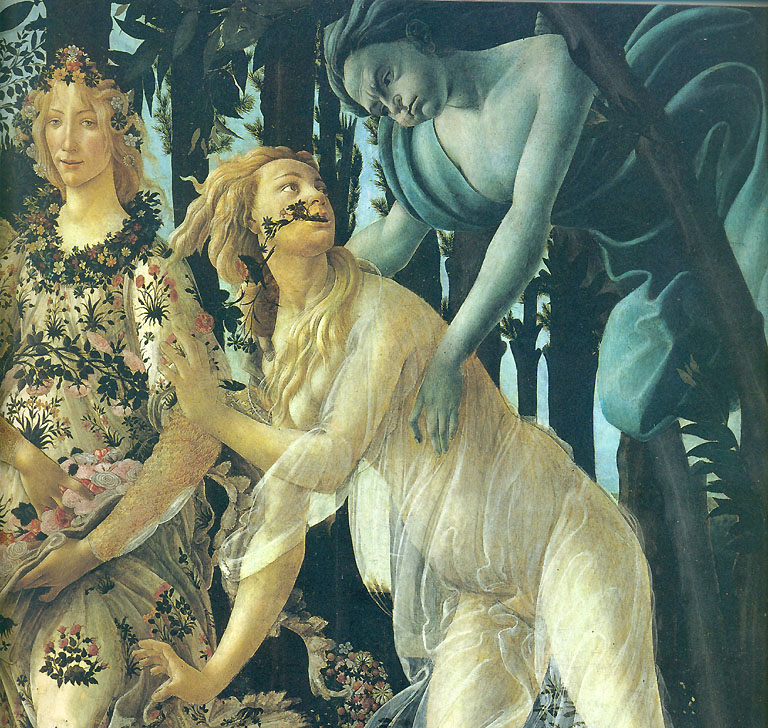
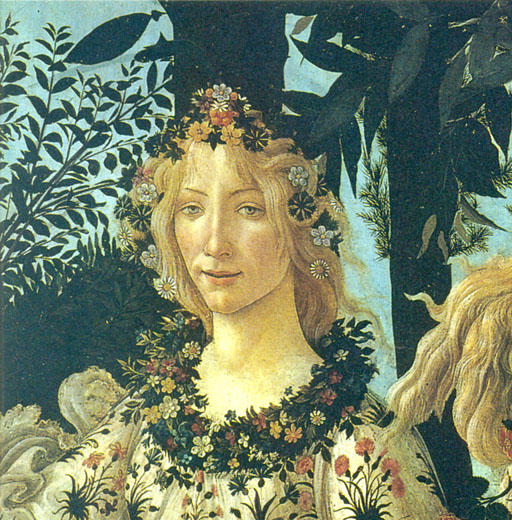
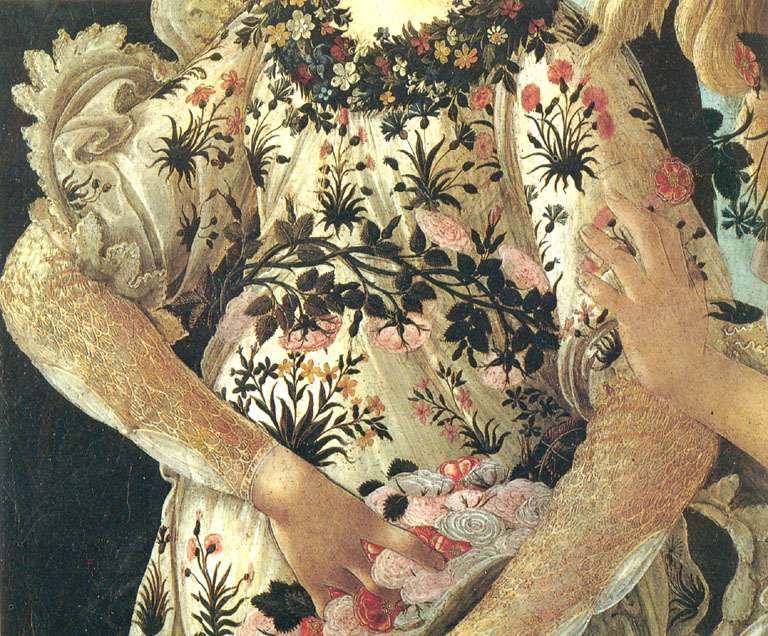
Details of Flora's face, the best-known in Botticelli's works, of Flora's robe which is like a rendering of the Grace's robe in the Birth of Venus. All of her movements are also the result of a deliberate distortion of the flowers and the bouquet of flowers she is preparing to throw to the world. Finally, Chloe, pursued by Zephyr who, in both instances has the same distended cheeks; in one case, he is blue, this is the winter Zephyr, in the other, the Birth of Venus, he is nearly yellow, this is the spring Zephyr.
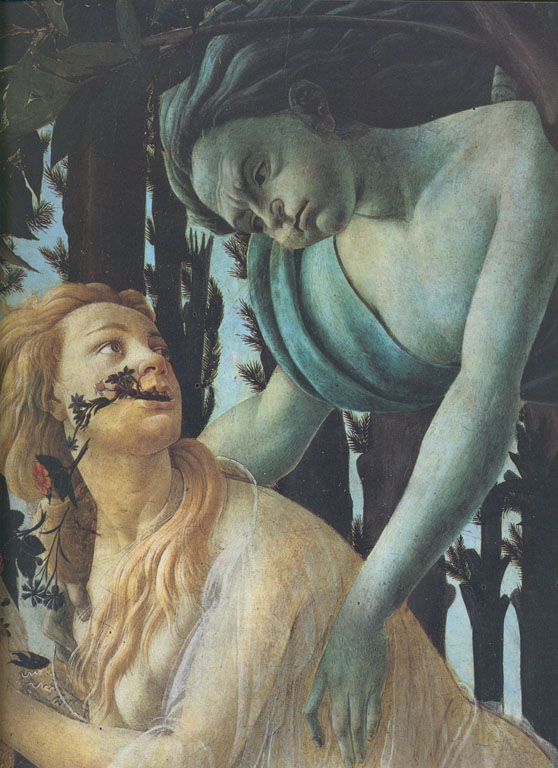
Leaving these paintings which represent one of the heights of Botticelli's profane painting, we hope that we have succeeded in demonstrating the extent to which it responds to an iconographic program, the extent to which this program is a myth and the extent to which the myth is meant to educate us about the primacy of sacred love over profane love. It is paramount to be aware of this, as we can already note that in the Christian paintings, Botticelli never even tries to educate. On the other hand, in the pagan paintings, from Mars and Venus on and mostly with the Birth of Venus and Spring, we can see that there is an attempt at education. It is rather extraordinary to realize that Botticelli is more at ease in this mythical didactic role with the "pagan" gods than with his perennial Christianity.
The last pagan work that we shall view tonight is a series of four superb paintings recounting an extraordinary story, that of Nastagio degli Onesti, taken from Boccaccio's Decameron, the fifth tale of the ninth day. This tale is interesting enough to merit a quick summary. It consists of four episodes chosen by Botticelli at the request of Lorenzo the Magnificent, who wanted to give them to his godson for his marriage. These four paintings were meant to adorn the paneling of their formal salon. Later, the paintings were dispersed: three are in Madrid, and the fourth is in a private American collection. The first three paintings are very well-known, and we'll be able to show them to you, but we have nothing for the fourth one, as the collector has always refused to allow it to be photographed.


First painting
The story of this Onesti character is one which would appear to be banal, but it is also as terrifying as a Hoffmann tale. It's a completely romantic tale. Degli Onesti is an honest young man strolling through the forest, terribly distressed because his fiancé had refused to marry him. Mad with despair, he has gone to the forest to be alone when he hears the sound of galloping hooves. He sees a nude woman appear before him, pursued by a pack of dogs, followed by a knight in armor screaming savagely and brandishing his sword at the woman. Details: in the center, degli Onesti meditating, at the right, taken by surprise at the sound of this incredible pursuit and mainly the discovery of the incredible nature of this hunt. This woman, completely drawn out to the left, as she is trying to escape a dog's teeth and the knight's sword. One can note the beauty of having left the rest of the landscape in total peace, going as far as the rather fabulous image of the grazing sheep.




Second painting
This is even worse than might have been expected, and the young man's horror proves it. The woman has finally fallen, bitten by the dogs, wounded by the sword. The knight then dismounts, cuts open her back and rips out her heart to feed it to his dogs. That is what we are viewing: degli Onesti is still there, panic-stricken, the woman whose back had been cut open, the man whose hands are scrabbling in her back and the dogs eating the young woman's heart. It would be no more than a gruesome incident, but, before the dogs have even had time to finish the heart, the woman gets to her feet and starts running again, the horse and dogs start the chase again, and degli Onesti realizes that he has witnessed a phantom hunt, a curse. Until the end of time, this woman would have to run, this man would have to kill her, cut her back open, rip out her heart and feed it to the dogs, over and over again. He learns all this when he goes home. Why this curse? Because he loved her, she turned him down and they were damned, and for this reason, he must kill her and steal her heart until the end of time. Botticelli shows us all this, and we witness all this horrifying carnage and the hunt's renewal. We see the woman take off in the other direction, the dogs and the rider at her heels. Details: the young woman whose heart had been ripped out, the group of dogs eating the heart and the beautiful figure of the horse on the right, then the renewal of the hunt, taking off in the other direction. Naturally, the vision haunting this forest gives degli Onesti a brilliant idea - degli Onesti invites his fiancé's family to a picnic in the forest..




Third painting
 Here is the picnic; Ugolino is there, there are nothing but phantoms, but we again witness the ghostly young woman's atrocious murder under the thrusts and blows of her ghostly lover's sword. We can see the horror of all these panic-stricken people. This is one of the most beautiful details: the dinner is overturned, yet the landscape remains absolutely calm - it's sublime.
These three paintings are among Botticelli's least-known but most beautiful paintings. They are in the Prado in Madrid. The missing fourth painting naturally represents the woman saying sweetly: "In that case, I'll marry you", and we are present for the marriage of Dona Lucrezia Bini and our Ugolino degli Onesti.
ybr>
We have now seen Botticelli's two worlds, the Christian world in which he has proven to be a genius of extraordinary painting, but also and more importantly, the pagan world, in which we cannot find pagan genius, but instead an extraordinary philosophical and "mythological" genius. We have been able to see that this generation of Pico della Mirandola and Marsilio Ficino was born from this same mythical world, the myth parable; of all the great humanists of his time, Botticelli was able to impart the most important lesson of all.
Here is the picnic; Ugolino is there, there are nothing but phantoms, but we again witness the ghostly young woman's atrocious murder under the thrusts and blows of her ghostly lover's sword. We can see the horror of all these panic-stricken people. This is one of the most beautiful details: the dinner is overturned, yet the landscape remains absolutely calm - it's sublime.
These three paintings are among Botticelli's least-known but most beautiful paintings. They are in the Prado in Madrid. The missing fourth painting naturally represents the woman saying sweetly: "In that case, I'll marry you", and we are present for the marriage of Dona Lucrezia Bini and our Ugolino degli Onesti.
ybr>
We have now seen Botticelli's two worlds, the Christian world in which he has proven to be a genius of extraordinary painting, but also and more importantly, the pagan world, in which we cannot find pagan genius, but instead an extraordinary philosophical and "mythological" genius. We have been able to see that this generation of Pico della Mirandola and Marsilio Ficino was born from this same mythical world, the myth parable; of all the great humanists of his time, Botticelli was able to impart the most important lesson of all.
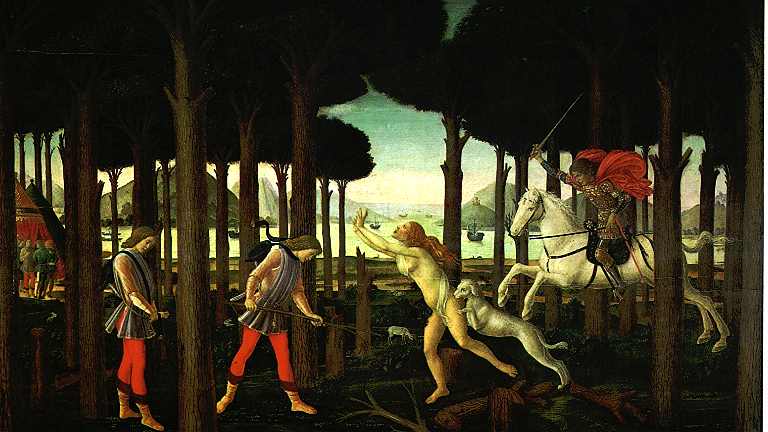

First painting
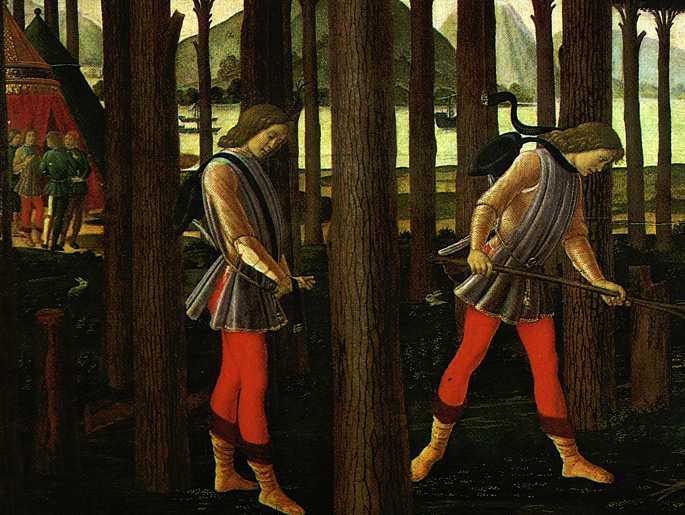
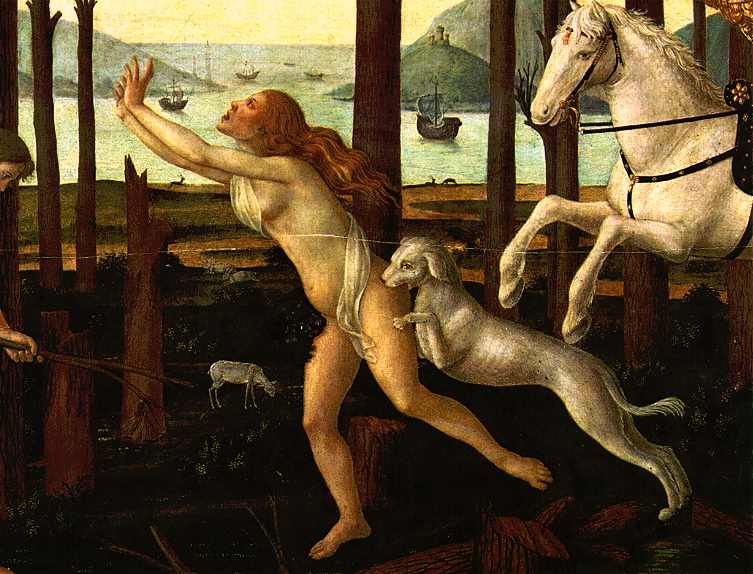


Second painting
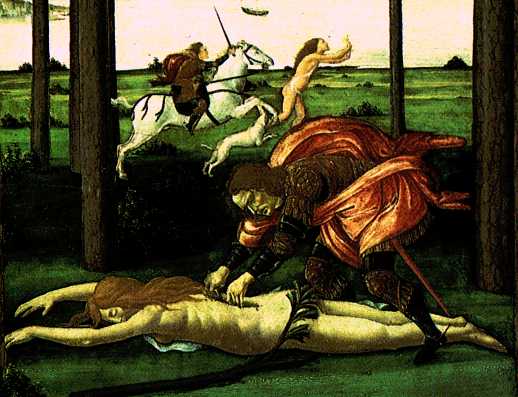
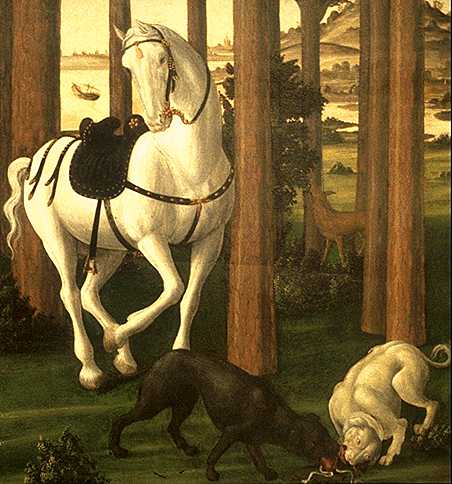
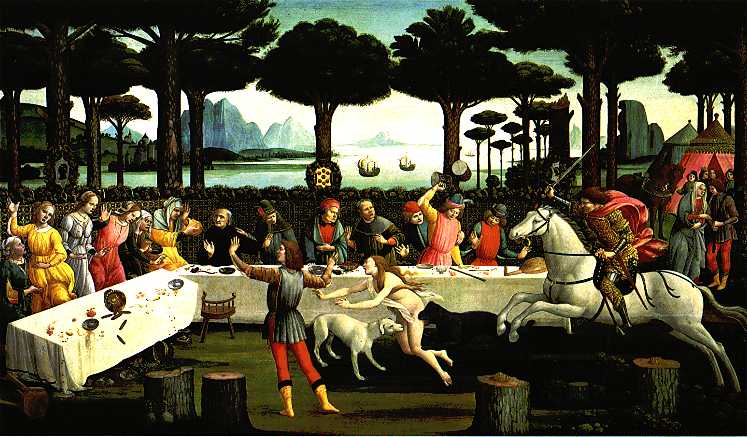

Third painting
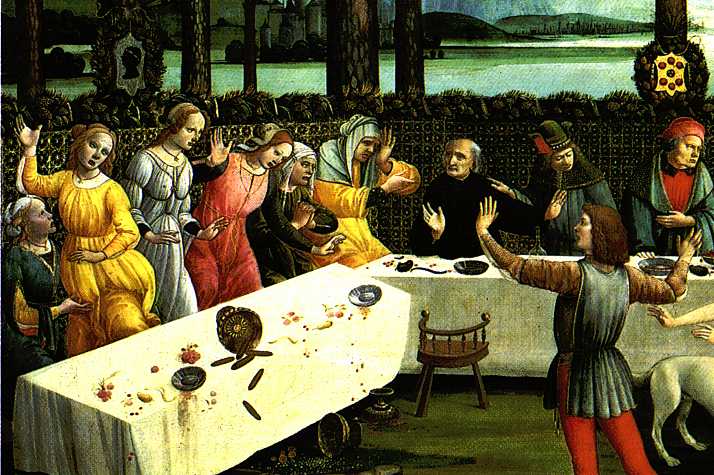 Here is the picnic; Ugolino is there, there are nothing but phantoms, but we again witness the ghostly young woman's atrocious murder under the thrusts and blows of her ghostly lover's sword. We can see the horror of all these panic-stricken people. This is one of the most beautiful details: the dinner is overturned, yet the landscape remains absolutely calm - it's sublime.
These three paintings are among Botticelli's least-known but most beautiful paintings. They are in the Prado in Madrid. The missing fourth painting naturally represents the woman saying sweetly: "In that case, I'll marry you", and we are present for the marriage of Dona Lucrezia Bini and our Ugolino degli Onesti.
ybr>
We have now seen Botticelli's two worlds, the Christian world in which he has proven to be a genius of extraordinary painting, but also and more importantly, the pagan world, in which we cannot find pagan genius, but instead an extraordinary philosophical and "mythological" genius. We have been able to see that this generation of Pico della Mirandola and Marsilio Ficino was born from this same mythical world, the myth parable; of all the great humanists of his time, Botticelli was able to impart the most important lesson of all.
Here is the picnic; Ugolino is there, there are nothing but phantoms, but we again witness the ghostly young woman's atrocious murder under the thrusts and blows of her ghostly lover's sword. We can see the horror of all these panic-stricken people. This is one of the most beautiful details: the dinner is overturned, yet the landscape remains absolutely calm - it's sublime.
These three paintings are among Botticelli's least-known but most beautiful paintings. They are in the Prado in Madrid. The missing fourth painting naturally represents the woman saying sweetly: "In that case, I'll marry you", and we are present for the marriage of Dona Lucrezia Bini and our Ugolino degli Onesti.
ybr>
We have now seen Botticelli's two worlds, the Christian world in which he has proven to be a genius of extraordinary painting, but also and more importantly, the pagan world, in which we cannot find pagan genius, but instead an extraordinary philosophical and "mythological" genius. We have been able to see that this generation of Pico della Mirandola and Marsilio Ficino was born from this same mythical world, the myth parable; of all the great humanists of his time, Botticelli was able to impart the most important lesson of all.
While still alive, Botticelli was already considered to be one of the greatest painters of all time, mainly because the Florentines themselves considered him to be the "cherished child of the gods". This therefore meant that the Florentines awaited and acclaimed every one of Botticelli's works. The great paintings were talked about, the Madonna of the Magnificat tondo in the sacred vein, the Birth of Venus or Spring, which were called profane, all these were discussed, but people forgot to talk about what his hands produced, what immediately become the object of the highest admiration: his drawings. It should be pointed out, and this is very important, that Botticelli was the first artist whose drawings were admired by collectors. In general, during the 15th century, a drawing was part of the preparation of a painting; once the painting was finished, it was thrown away. Botticelli gave drawings their exalted existence because, in the actual drawing, his hands produced something of the miraculous. We are going to look at several drawings and admire the mastery.


Study for the Mystic Nativity
An admirable enhanced drawing which is neither a study for a painting, nor a study for anything at all, but a Pomona drawn in red chalk with white highlights which was given to Lorenzo the Magnificent as a work in its own right.


Pomone


Study for the Adoration of the Magi (Medici)
Notably a study of these expressive heads and, at the same time a study of these horses, extraordinary in their liberty, horses with four or six eyes as Botticelli made corrections as he drew.


The Allegory of Abundance


Study for the Saint Barnabas Altarpiece
One of the angels parting the curtain. We should note that from the first drawing to the second and from the second to the third, but even more from the third to the fourth, Botticelli's drawings increasingly take on a totally separate language. One has the distinct feeling that the first and second drawings are still preliminary drawings, but from the third and fourth on, they become art unto themselves. One of the very important parts of Botticelli's contribution to his century is to have, so to speak, given the drawings nobility as a means of plastic expression. And he was, moreover, one of the first to have given drawings away.
We are somewhat in debt to Sandro Botticelli for the admiration we still have today in the 20th century for drawings, and also for the fervor of collectors of drawings in the history of collections. It is true that when one is capable of simultaneously filling a sheet of paper with such evanescence and such sureness of hand, one could well be considered the father of drawing. It is very curious that, shortly after his death, the drawings were in such demand that forgers were asked to continue making them.
We can add this small additional section on the invention of the art of drawing to what we have already learned about Botticelli - it's very important.
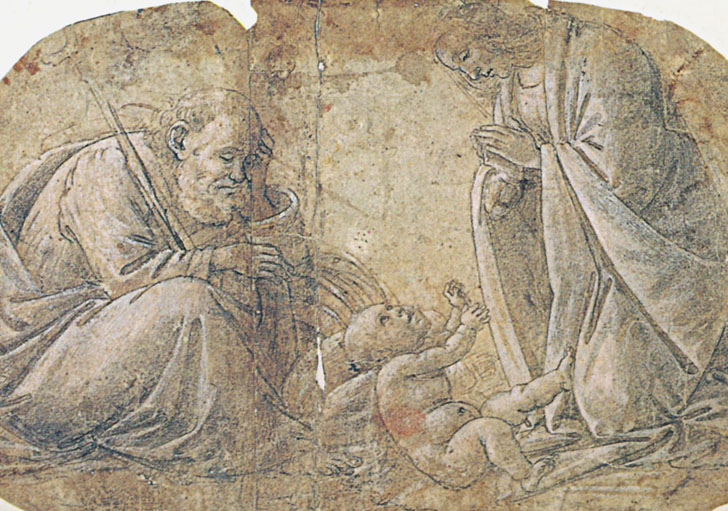

Study for the Mystic Nativity
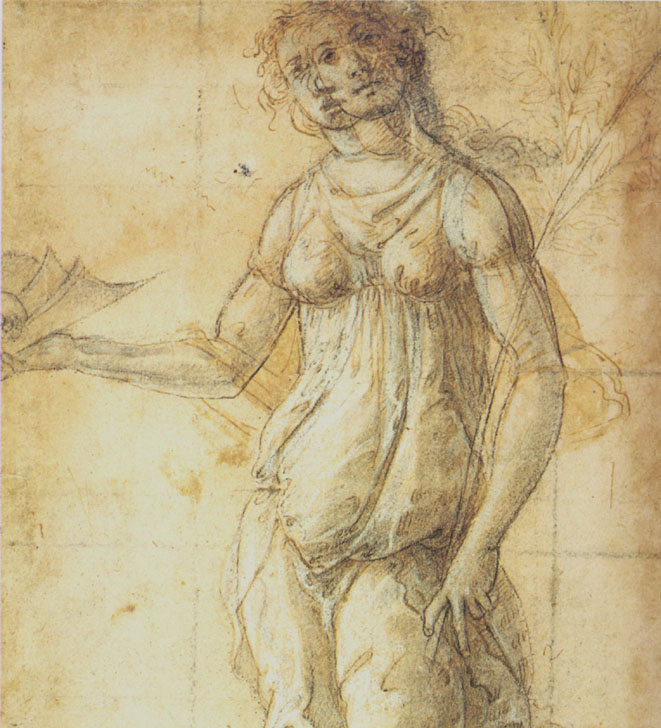

Pomone
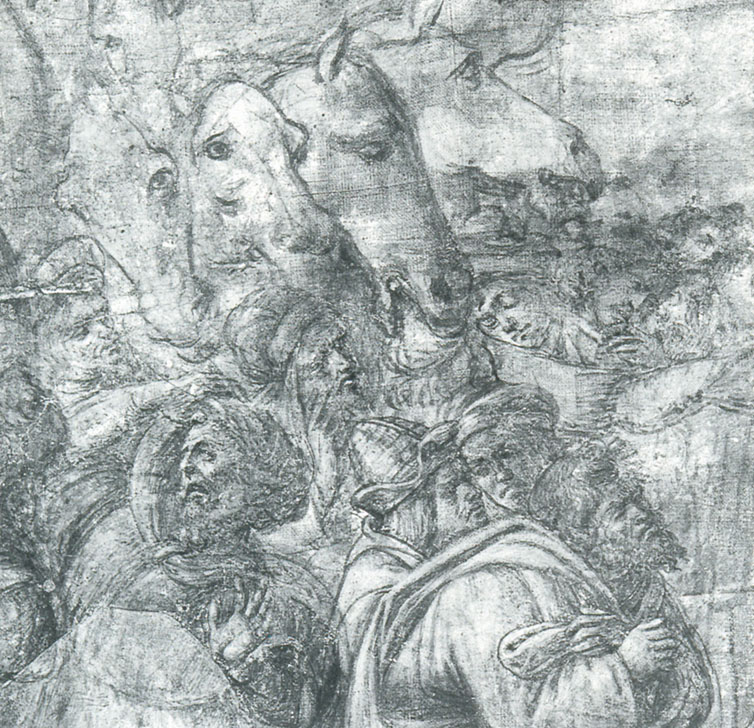

Study for the Adoration of the Magi (Medici)
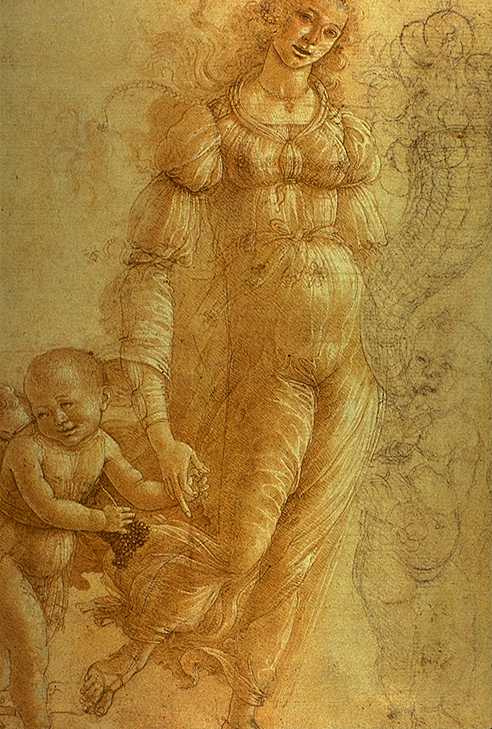

The Allegory of Abundance
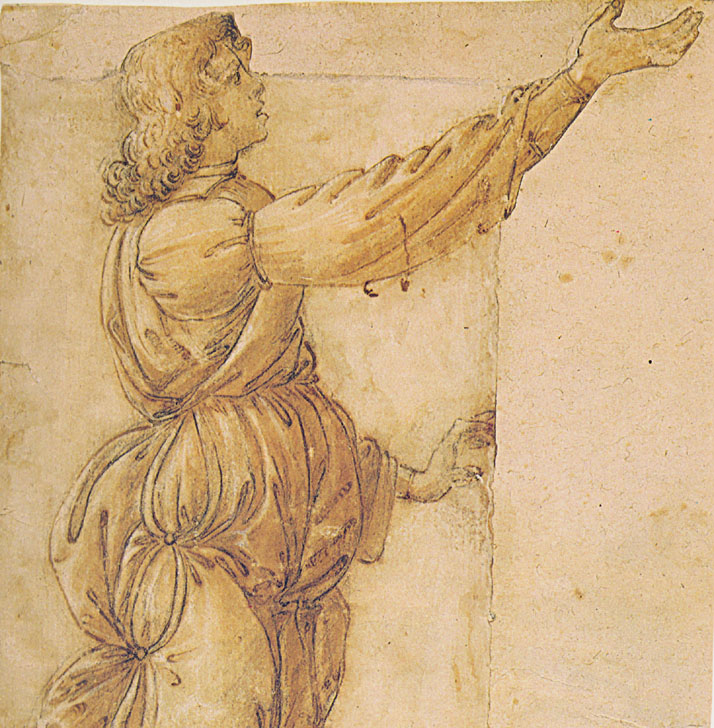

Study for the Saint Barnabas Altarpiece
We are somewhat in debt to Sandro Botticelli for the admiration we still have today in the 20th century for drawings, and also for the fervor of collectors of drawings in the history of collections. It is true that when one is capable of simultaneously filling a sheet of paper with such evanescence and such sureness of hand, one could well be considered the father of drawing. It is very curious that, shortly after his death, the drawings were in such demand that forgers were asked to continue making them.
We can add this small additional section on the invention of the art of drawing to what we have already learned about Botticelli - it's very important.
Botticelli also invented the ideal: he was a child of the gods, he could paint only what the gods deigned to show him. He was one of the first artists of the Italian Renaissance who was not content to simply paint what he could see, but to paint what he could not see, what Plato and the Neo-Platonics themselves, so important in his training, called the ideal.
It should be noted that, little by little, wrinkles, flaws and scars on the faces, everything in excess, disappeared and slowly reached the high ground known as the ideal. Botticelli had immediately adopted this commitment to paint beyond beauty, this reflection behind beauty, which is wonderfully perceived. This privilege of the artist to paint beyond beauty itself is a privilege which was exploited mostly by the High Renaissance painters, but the first of these artists to feel the need to go behind the mirror of daily life was truly Botticelli. The most incredible thing is that if you read the works of the man who "knew" him best, i.e., Vasari, whom we know to have read the direct sources, we learn the following: at the end of his life, Botticelli was a poor man, alone, bitter, abandoned and forgotten. Naturally, from that time on, art historians have thrown themselves on Vasari's words in an attempt to understand what he meant. It was discovered that at the end of his life, Botticelli no longer had commissions, that he no longer had visitors and didn't speak, that he was very withdrawn from everything; reasons for this were sought.
It has been said that his Savonarolism had become a burden for him immediately after Savonarola's death. He was asked to recant and refused and was thus rejected. This first explanation doesn't hold water: Botticelli had never been a Savonarolan, he listened to him, he understood him and even put his words to canvas in the Mystic Nativity, but he was never a committed Savonarolan. No document listing those in disfavor because of their Savonarolism contained Botticelli's name - this is thus wrong.
The second thing considered was that Sandro Botticelli did not much care for women, but, on the contrary, rather frenetically liked young men. During his early years, this was still accepted, but, a little later on, the Florentines wanted nothing more to do with him because of this. It should be pointed out that during the same era, there was an even more "frenetic painter"; he had been nicknamed "il sodoma" [the sodomite], and this was used as a noble title. Why would Botticelli have been set aside for that? This is not the reason either. As these are the only two reasons suggested, we shall proffer a third, our own conclusion: what if, in fact, Botticelli had reached the end of his cycle? What if he had shown what he had to show, said what he had to say; what if he had painted what he had to paint, what if he had singled out what he wanted to single out, such as drawing and what if, in his last years, he was devoted to himself, to experience more intensely the one thing which, according to his contemporaries, was the most important thing to him: silence. In this disorderly Florence of the second half of the 15th century with which he was ceaselessly associated by virtue of his craft, what Botticelli could not abide was noise, passion, what he needed was silence. This is why, to conclude, we shall look at some works which give the impression in which Botticelli, so to speak, incarnated himself. They are always images of people who found silence.

Pieta

When he came back to the same subject several years later, we find exactly the same thing in a much more skillful and dramatic composition - it's sublime. Once again, we have a strange Christ who has closed his eyes and ears to the world, and this strange Christ yet again resembles Botticelli in an astounding manner. He did not want to do self-portraits, but, unconsciously, he wanted to find in Christ the silence to which he so aspired.


Still in private hands in a Roman collection, this work represents an unknown person, all alone in front of a door. Many allusions have been made with respect to this painting: it had been said that it was Lucrezia, abused by Tarquinius, it has been said that it was Mardochius at the temple door, but we don't care. It's quite simply the image of the quest for silence which goes so far as to completely fill the architectural austerity of this piece.


Saint Augustine
It is in this image of Saint Augustine that Botticelli perhaps invested the most of himself; it should be pointed out that according to Scripture, Saint Augustine did not hear the wind blow for thirty years, so intent was he in his search for God. One of Botticelli's greatest masterpieces is a small fresco in the Church of Ognissanti, near the house in which he was born, in which he depicts Saint Augustine at work. His face resembles the expectation of silence, of what lies beyond silence. We might even believe that, in fact, Botticelli, who had witnessed the birth of everything, the arts and even science, and even geometry and even the clock, this Botticelli wanted, at the end of his life, this luxury of silence which he could afford.


This is why, faced with a work which, at first glance, might appear to be a desperate one, Jacques-Edouard Berger cannot help but conclude by telling us that at one point in his life, Botticelli had had the luck and good fortune to have been able to offer himself the luxury of silence which his century had taken from him and, as such, he was certainly a happy man.
It should be noted that, little by little, wrinkles, flaws and scars on the faces, everything in excess, disappeared and slowly reached the high ground known as the ideal. Botticelli had immediately adopted this commitment to paint beyond beauty, this reflection behind beauty, which is wonderfully perceived. This privilege of the artist to paint beyond beauty itself is a privilege which was exploited mostly by the High Renaissance painters, but the first of these artists to feel the need to go behind the mirror of daily life was truly Botticelli. The most incredible thing is that if you read the works of the man who "knew" him best, i.e., Vasari, whom we know to have read the direct sources, we learn the following: at the end of his life, Botticelli was a poor man, alone, bitter, abandoned and forgotten. Naturally, from that time on, art historians have thrown themselves on Vasari's words in an attempt to understand what he meant. It was discovered that at the end of his life, Botticelli no longer had commissions, that he no longer had visitors and didn't speak, that he was very withdrawn from everything; reasons for this were sought.
It has been said that his Savonarolism had become a burden for him immediately after Savonarola's death. He was asked to recant and refused and was thus rejected. This first explanation doesn't hold water: Botticelli had never been a Savonarolan, he listened to him, he understood him and even put his words to canvas in the Mystic Nativity, but he was never a committed Savonarolan. No document listing those in disfavor because of their Savonarolism contained Botticelli's name - this is thus wrong.
The second thing considered was that Sandro Botticelli did not much care for women, but, on the contrary, rather frenetically liked young men. During his early years, this was still accepted, but, a little later on, the Florentines wanted nothing more to do with him because of this. It should be pointed out that during the same era, there was an even more "frenetic painter"; he had been nicknamed "il sodoma" [the sodomite], and this was used as a noble title. Why would Botticelli have been set aside for that? This is not the reason either. As these are the only two reasons suggested, we shall proffer a third, our own conclusion: what if, in fact, Botticelli had reached the end of his cycle? What if he had shown what he had to show, said what he had to say; what if he had painted what he had to paint, what if he had singled out what he wanted to single out, such as drawing and what if, in his last years, he was devoted to himself, to experience more intensely the one thing which, according to his contemporaries, was the most important thing to him: silence. In this disorderly Florence of the second half of the 15th century with which he was ceaselessly associated by virtue of his craft, what Botticelli could not abide was noise, passion, what he needed was silence. This is why, to conclude, we shall look at some works which give the impression in which Botticelli, so to speak, incarnated himself. They are always images of people who found silence.

Pieta
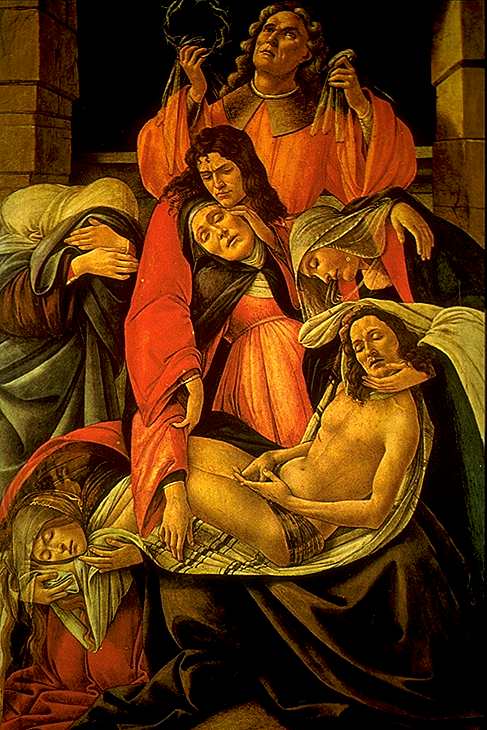
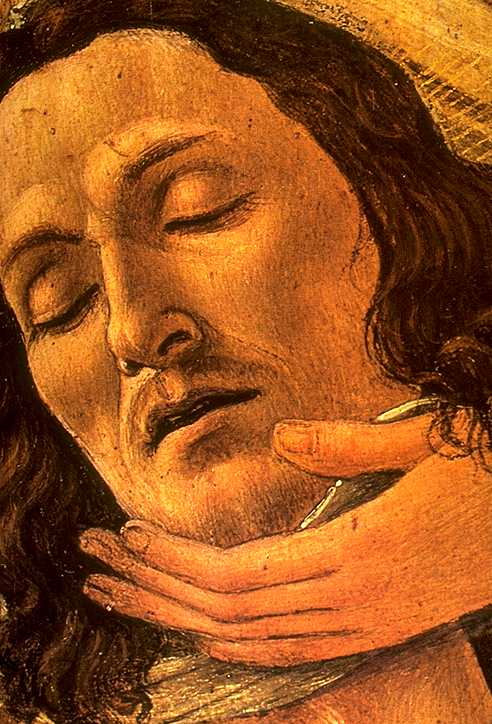
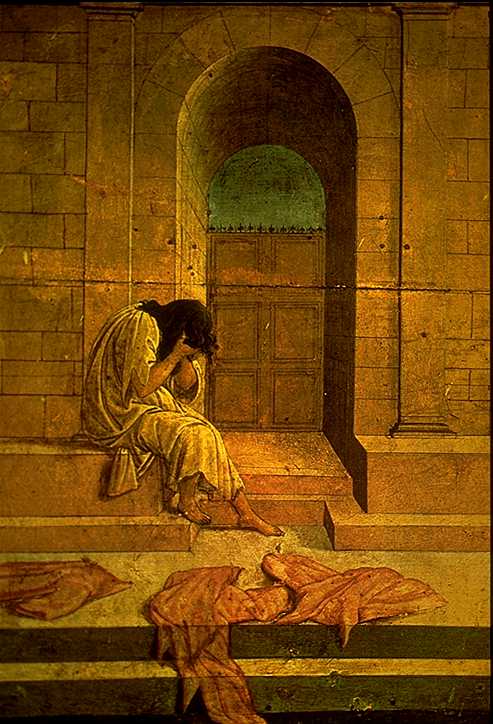

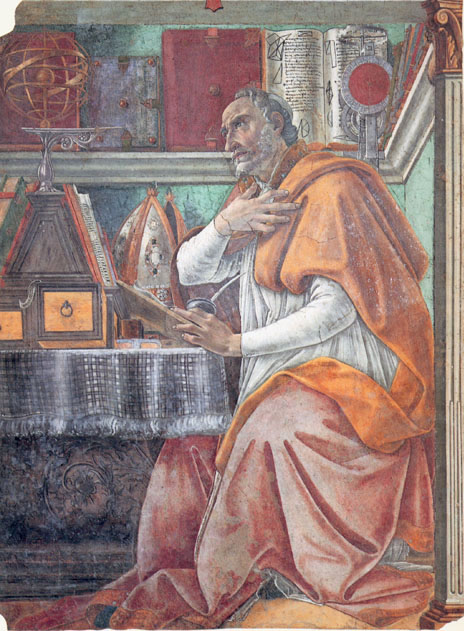

Saint Augustine
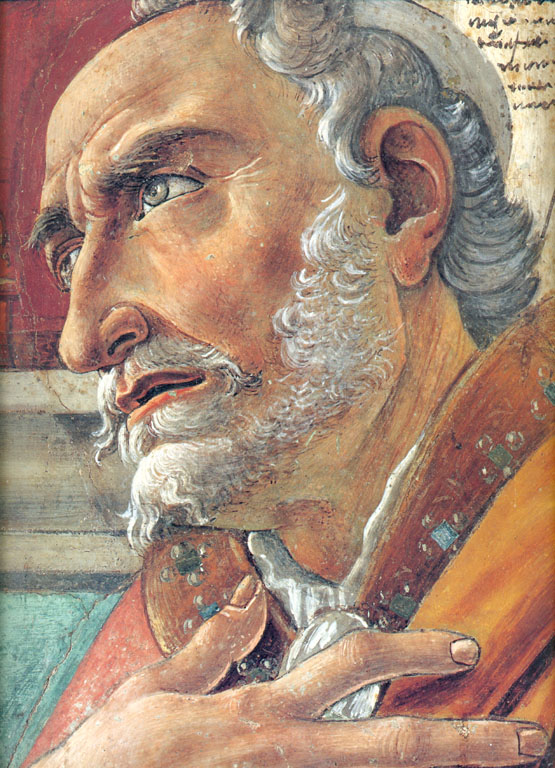
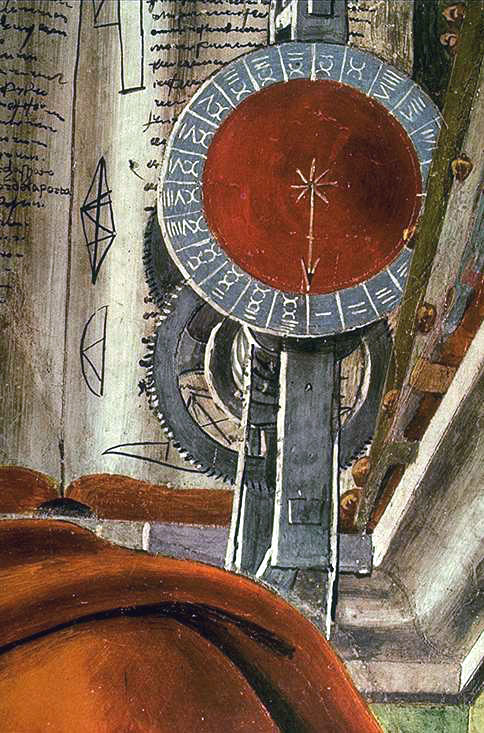
This is why, faced with a work which, at first glance, might appear to be a desperate one, Jacques-Edouard Berger cannot help but conclude by telling us that at one point in his life, Botticelli had had the luck and good fortune to have been able to offer himself the luxury of silence which his century had taken from him and, as such, he was certainly a happy man.

